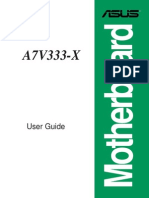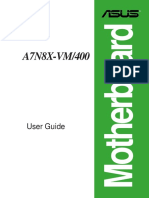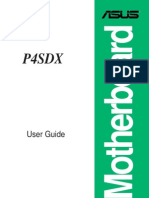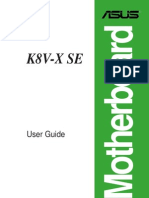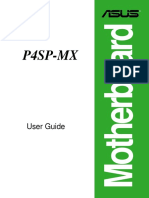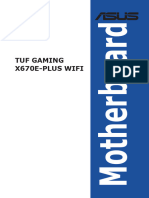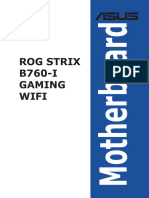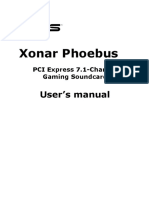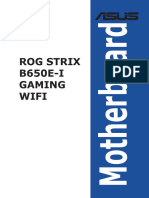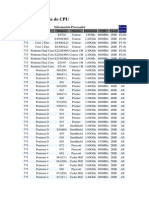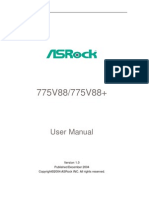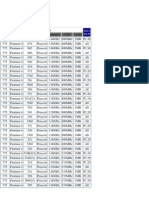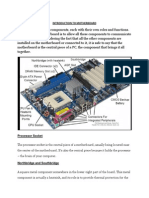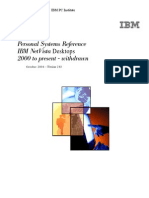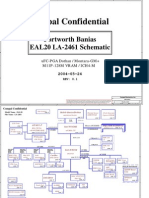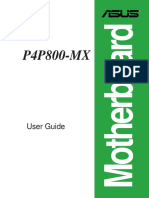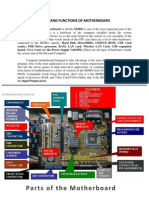Placa Base Asus P4PE-X TE PDF
Placa Base Asus P4PE-X TE PDF
Uploaded by
Infonova RuteCopyright:
Available Formats
Placa Base Asus P4PE-X TE PDF
Placa Base Asus P4PE-X TE PDF
Uploaded by
Infonova RuteOriginal Title
Copyright
Available Formats
Share this document
Did you find this document useful?
Is this content inappropriate?
Copyright:
Available Formats
Placa Base Asus P4PE-X TE PDF
Placa Base Asus P4PE-X TE PDF
Uploaded by
Infonova RuteCopyright:
Available Formats
M
o
t
h
e
r
b
o
a
r
d
P4PE-X/TE
User Guide
ii
C
h
e
c
k
l
i
s
t
Copyright 2003 ASUSTeK COMPUTER INC. All Rights Reserved.
No part of this manual, including the products and software described in it, may be
reproduced, transmitted, transcribed, stored in a retrieval system, or translated into any
language in any form or by any means, except documentation kept by the purchaser for
backup purposes, without the express written permission of ASUSTeK COMPUTER INC.
(ASUS).
Product warranty or service will not be extended if: (1) the product is repaired, modified or
altered, unless such repair, modification of alteration is authorized in writing by ASUS; or (2)
the serial number of the product is defaced or missing.
ASUS PROVIDES THIS MANUAL AS IS WITHOUT WARRANTY OF ANY KIND, EITHER
EXPRESS OR IMPLIED, INCLUDING BUT NOT LIMITED TO THE IMPLIED WARRANTIES
OR CONDITIONS OF MERCHANTABILITY OR FITNESS FOR A PARTICULAR PURPOSE.
IN NO EVENT SHALL ASUS, ITS DIRECTORS, OFFICERS, EMPLOYEES OR AGENTS BE
LIABLE FOR ANY INDIRECT, SPECIAL, INCIDENTAL, OR CONSEQUENTIAL DAMAGES
(INCLUDING DAMAGES FOR LOSS OF PROFITS, LOSS OF BUSINESS, LOSS OF USE
OR DATA, INTERRUPTION OF BUSINESS AND THE LIKE), EVEN IF ASUS HAS BEEN
ADVISED OF THE POSSIBILITY OF SUCH DAMAGES ARISING FROM ANY DEFECT OR
ERROR IN THIS MANUAL OR PRODUCT.
SPECIFICATIONS AND INFORMATION CONTAINED IN THIS MANUAL ARE FURNISHED
FOR INFORMATIONAL USE ONLY, AND ARE SUBJECT TO CHANGE AT ANY TIME
WITHOUT NOTICE, AND SHOULD NOT BE CONSTRUED AS A COMMITMENT BY ASUS.
ASUS ASSUMES NO RESPONSIBILITY OR LIABILITY FOR ANY ERRORS OR
INACCURACIES THAT MAY APPEAR IN THIS MANUAL, INCLUDING THE PRODUCTS
AND SOFTWARE DESCRIBED IN IT.
Products and corporate names appearing in this manual may or may not be registered
trademarks or copyrights of their respective companies, and are used only for identification or
explanation and to the owners benefit, without intent to infringe.
E1474
Revised Edition V2a
November 2003
iii
F
e
a
t
u
r
e
s
Contents
Notices ............................................................................................ v
Safety information .......................................................................... vi
About this guide............................................................................. vii
Conventions used in this guide ............................................ vii
Where to find more information ............................................ vii
ASUS contact information ............................................................ viii
P4PE-X/TE specifications summary ............................................... ix
Chapter 1: Product introduction ........................................... 1-1
1.1 Welcome! ........................................................................... 1-2
1.2 Package contents ............................................................... 1-2
1.3 Special features.................................................................. 1-2
1.4 Motherboard components .................................................. 1-4
1.5 Motherboard layout ............................................................ 1-7
1.6 Before you proceed ............................................................ 1-8
1.7.1 Placement direction ............................................... 1-9
1.7.2 Screw holes ........................................................... 1-9
1.7 Motherboard installation ..................................................... 1-9
1.8 Central Processing Unit (CPU) ......................................... 1-10
1.8.1 Overview.............................................................. 1-10
1.8.2 Installing the CPU ................................................. 1-11
1.9 System memory ............................................................... 1-12
1.9.1 Memory configurations ........................................ 1-12
1.9.2 Installing a DIMM ................................................. 1-13
1.10 Expansion slots ................................................................ 1-14
1.10.1 Standard interrupt assignments ........................... 1-14
1.10.2 IRQ assignments for this motherboard ................ 1-14
1.11 Jumpers............................................................................ 1-15
1.12 Connectors ....................................................................... 1-16
Chapter 2: BIOS information ................................................. 2-1
2.1 Managing and updating your BIOS .................................... 2-2
2.1 Managing and updating your BIOS .................................... 2-2
2.1.1 Using ASUS EZ Flash to update the BIOS ............ 2-2
2.1.2 Using AFLASH to update the BIOS ....................... 2-4
iv
S
a
f
e
g
u
a
r
d
s
Contents
2.1.3 Recovering the BIOS with CrashFree BIOS 2 ....... 2-7
2.1.4 BIOS beep codes ................................................... 2-8
2.2 BIOS Setup program.......................................................... 2-9
2.2.1 BIOS menu bar ...................................................... 2-9
2.2.2 Legend bar ........................................................... 2-10
2.3 Main Menu......................................................................... 2-11
2.3.1 Primary and Secondary Master/Slave ................. 2-13
2.3.2 Keyboard Features .............................................. 2-15
2.4 Advanced Menu ............................................................... 2-16
2.4.1 Chip Configuration ............................................... 2-19
2.4.2 I/O Device Configuration...................................... 2-21
2.4.3 PCI Configuration ................................................ 2-22
2.5 Power Menu ..................................................................... 2-24
2.5.1 Power Up Control ................................................ 2-26
2.5.2 Hardware Monitor ................................................ 2-28
2.6 Boot Menu ........................................................................ 2-29
2.7 Exit Menu ......................................................................... 2-31
Chapter 3: Software support ................................................. 3-1
3.1 Install an operating system................................................. 3-2
3.2 Support CD information ...................................................... 3-2
3.2.1 Running the support CD ........................................ 3-2
3.2.2 Drivers menu ......................................................... 3-3
3.2.3 Utilities menu ......................................................... 3-4
3.2.4 ASUS Contact Information ..................................... 3-5
v
Notices
Federal Communications Commission Statement
This device complies with Part 15 of the FCC Rules. Operation is subject to
the following two conditions:
This device may not cause harmful interference, and
This device must accept any interference received, including interference
that may cause undesired operation.
This equipment has been tested and found to comply with the limits for a
Class B digital device, pursuant to Part 15 of the FCC Rules. These limits
are designed to provide reasonable protection against harmful interference
in a residential installation. This equipment generates, uses and can radiate
radio frequency energy and, if not installed and used in accordance with
manufacturers instructions, may cause harmful interference to radio
communications. However, there is no guarantee that interference will not
occur in a particular installation. If this equipment does cause harmful
interference to radio or television reception, which can be determined by
turning the equipment off and on, the user is encouraged to try to correct the
interference by one or more of the following measures:
Reorient or relocate the receiving antenna.
Increase the separation between the equipment and receiver.
Connect the equipment to an outlet on a circuit different from that to
which the receiver is connected.
Consult the dealer or an experienced radio/TV technician for help.
Canadian Department of Communications Statement
This digital apparatus does not exceed the Class B limits for radio noise
emissions from digital apparatus set out in the Radio Interference
Regulations of the Canadian Department of Communications.
This class B digital apparatus complies with Canadian ICES-003.
The use of shielded cables for connection of the monitor to the
graphics card is required to assure compliance with FCC regulations.
Changes or modifications to this unit not expressly approved by the
party responsible for compliance could void the users authority to
operate this equipment.
vi
Safety information
Electrical safety
To prevent electrical shock hazard, disconnect the power cable from
the electrical outlet before relocating the system.
When adding or removing devices to or from the system, ensure that
the power cables for the devices are unplugged before the signal
cables are connected. If possible, disconnect all power cables from the
existing system before you add a device.
Before connecting or removing signal cables from the motherboard,
ensure that all power cables are unplugged.
Seek professional assistance before using an adpater or extension
cord. These devices could interrupt the grounding circuit.
Make sure that your power supply is set to the correct voltage in your
area. If you are not sure about the voltage of the electrical outlet you
are using, contact your local power company.
If the power supply is broken, do not try to fix it by yourself. Contact a
qualified service technician or your retailer.
Operation safety
Before installing the motherboard and adding devices on it, carefully
read all the manuals that came with the package.
Before using the product, make sure all cables are correctly connected
and the power cables are not damaged. If you detect any damage,
contact your dealer immediately.
To avoid short circuits, keep paper clips, screws, and staples away from
connectors, slots, sockets and circuitry.
Avoid dust, humidity, and temperature extremes. Do not place the
product in any area where it may become wet.
Place the product on a stable surface.
If you encounter technical problems with the product, contact a
qualified service technician or your retailer.
vii
About this guide
Conventions used in this guide
To make sure that you perform certain tasks properly, take note of the
following symbols used throughout this manual.
Where to find more information
Refer to the following sources for additional information and for product
and software updates.
1. ASUS Websites
The ASUS websites worldwide provide updated information on ASUS
hardware and software products. The ASUS websites are listed in the
ASUS Contact Information on page viii.
2. Optional Documentation
Your product package may include optional documentation, such as
warranty flyers, that may have been added by your dealer. These
documents are not part of the standard package.
WARNING: Information to prevent injury to yourself when trying
to complete a task.
CAUTION: Information to prevent damage to the components
when trying to complete a task.
IMPORTANT: Information that you MUST follow to complete a
task.
NOTE: Tips and additional information to aid in completing a task.
viii
ASUS contact information
ASUSTeK COMPUTER INC. (Asia-Pacific)
Address: 150 Li-Te Road, Peitou, Taipei, Taiwan 112
General Tel: +886-2-2894-3447
General Fax: +886-2-2894-3449
Web Site: www.asus.com.tw
Technical Support
MB/Others (Tel): +886-2-2890-7121 (English)
Notebook (Tel): +886-2-2890-7122 (English)
Desktop/Server (Tel): +886-2-2890-7123 (English)
Support Fax: +886-2-2890-7698
ASUS COMPUTER INTERNATIONAL (America)
Address: 44370 Nobel Drive, Fremont, CA 94538, USA
General Fax: +1-502-933-8713
General Email: tmd1@asus.com
Web Site: usa.asus.com
Technical Support
Support Fax: +1-502-933-8713
General Support: +1-502-995-0883
Notebook Support: +1-510-739-3777 x5110
Support Email: tsd@asus.com
ASUS COMPUTER GmbH (Germany and Austria)
Address: Harkortstr. 25, 40880 Ratingen, BRD, Germany
General Email: sales@asuscom.de (for marketing requests only)
General Fax: +49-2102-9599-31
Web Site: www.asuscom.de
Technical Support
Components: +49-2102-9599-0
Notebook PC: +49-2102-9599-10
Support Fax: +49-2102-9599-11
Support Email: www.asuscom.de/support (for online support)
ASUSTeK COMPUTER (Middle East and North Africa)
Address: P.O. Box 64133, Dubai, U.A.E.
General Tel: +9714-283-1774
General Fax: +9714-283-1775
Web Site: www.ASUSarabia.com
ix
P4PE-X/TE specifications summary
(continued on the next page)
CPU
Chipset
Front Side Bus (FSB)
Memory
Expansion slots
IDE
Audio
LAN
Special features
Rear panel I/O
Internal I/O
Socket 478 for Intel
Pentium
4 / Celeron processors with
speeds of up to 3.06+ GHz
Intel
Hyper-Threading technology ready
Intel 82845PE MCH
Intel 82801DB ICH4
800*/533/400 MHz
(*Overclocked mode, a CPU with 800MHz FSB requires using a PC3200 DIMM)
3 x 184-pin DDR DIMM sockets for up to 2GB memory
Supports PC3200*/2700/2100/1600 unbuffered non-ECC
DDR DIMMs (*Overclocked mode, a PC3200 DIMM requires a CPU with
800MHz FSB. Obtain PC3200 DDR DIMMs only from ASUS qualified vendors.)
1 x AGP 4X (1.5V only)
6 x PCI
2 x UltraDMA100/66/33 connectors
ADI AD1888 6-channel audio CODEC
Realtek
RTL8100C Fast Ethernet controller
ASUS JumperFree mode
ASUS EZ Flash
ASUS CrashFree BIOS2
ASUS CPU Parameter Recall (C.P.R.)
USB 2.0 ready
Power Loss Restart
SFS (Stepless Frequency Selection)
CPU throttle
Adjustable CPU Vcore
1 x Parallel port
2 x Serial ports
1 x PS/2 keyboard port
1 x PS/2 mouse port
4 x USB 2.0/USB 1.1 ports
1 x RJ-45 port
Line In/Line Out/Microphone ports
1 x USB 2.0/1.1 connector for 2 additional USB ports
CPU/Chassis fan connectors
20-pin/4-pin ATX 12V power connectors
IDE LED connector
Chassis intrusion connector
GAME/MIDI connector
S/PDIF Out connector
CD/AUX audio connectors
Front panel audio connector
x
P4PE-X/TE specifications summary
* Specifications are subject to change without notice.
BIOS features
Industry standard
Manageability
Form Factor
Support CD contents
2Mb Flash ROM, Award BIOS, TCAV, PnP, DMI2.0, SM
BIOS2.3, ASUS C.P.R., ASUS EZ Flash, ASUS CrashFree
BIOS2
PCI 2.2, USB 2.0
WfM 2.0. DMI 2.0, WOL/WOR by PME, chassis intrusion,
SMBus
ATX form factor: 12 in x 9.0 in (30.5 cm x 22.9 cm)
Device drivers
ASUS PC Probe
ASUS LiveUpdate
Trend Micro PC-cillin 2002 anti-virus software (OEM version)
Chapter 1
This chapter describes the features of the
P4PE-X/TE motherboard. It includes brief
descriptions of the motherboard components,
and illustrations of the layout, jumper settings,
and connectors.
Product introduction
1-2 Chapter 1: Product introduction
1.1 Welcome!
Thank you for buying the ASUS
P4PE-X/TE motherboard!
The ASUS
P4PE-X/TE motherboard delivers a host of new features and latest
technologies making it another standout in the long line of ASUS quality
motherboards!
The motherboard incorporates the Intel
Pentium
4 Processor in 478-pin package
coupled with the Intel
845PE chipset to set a new benchmark for a cost-effective
desktop platform solution.
Supporting up to 2GB of system memory with PC3200*/2700/2100/1600 DDR
SDRAM, high-resolution graphics via an AGP 4X slot, USB 2.0, 10/100 Mbps LAN
and 6-channel audio features, the P4PE-X/TE is your affordable vehicle to enter
the world of computing!
Before you start installing the motherboard, and hardware devices on it, check the
items in your package with the list below.
*Overclocking mode
1.2 Package contents
Check your P4PE-X/TE package for the following items.
ASUS P4PE-X/TE motherboard
ATX form factor: 12 in x 9 in (30.5 cm x 22.9 cm)
ASUS P4PE-X/TE series support CD
1 x 80-conductor ribbon cables for UltraDMA/66/100/133 IDE drives
1 x Ribbon cable for a 3.5-inch floppy drive
1 x I/O shield
Bag of extra jumper caps
User Guide
If any of the above items is damaged or missing, contact your retailer.
1.3 Special features
Latest processor technology
The P4PE-X/TE motherboard supports the latest Intel
Pentium
4 Processor via a
478-pin surface mount ZIF socket. See page 1-10 for more information.
ASUS P4PE-X/TE motherboard user guide 1-3
DDR memory support
Employing the Double Data Rate (DDR) memory technology, the P4PE-X/TE
motherboard supports up to 2GB of system memory using unbuffered non-ECC
PC3200*/2700/2100/1600 DDR DIMMs. Memory support depends on the CPU
FSB and DDR type. See page 1-12 for the CPU and DIMM requirements.
*Overclocking mode
Onboard LAN solution
The motherboard has the Realtek
RTL8100C chipset onboard to support
10BASE-T/100BASE-TX networking protocol. See pages 1-4
USB 2.0 technology
The motherboard implements the new Universal Serial Bus (USB) 2.0
specification, extending the connection speed from 12 Mbps on USB 1.1 to a fast
480 Mbps on USB 2.0. See page 1-16.
6-channel digital audio
The ADI AD1888 AC 97 audio CODEC is onboard to provide 6-channel audio
playback capability. A digital audio connector is present to accommodate the Sony/
Philips Digital Interface (S/PDIF) Out module. See page 1-18.
Extreme Overclocking
The P4PE-X/TE offers robust overclocking options to maximize your system
performance. Overclocking features include: a flexible CPU core voltage
adjustment in 0.025V increments over defaults, the SFS (Stepless Frequency
Selection) feature, an adjustable FSB/DDR ratio with a fixed AGP/PCI frequency
and the ASUS C.P.R. (CPU Parameter Recall).
ASUS EZ Flash BIOS
With the ASUS EZ Flash, you can easily update the system BIOS even before loading
the operating system. No need to use a DOS-based utility or boot from a floppy disk.
See page 2.2.
C.P.R. (CPU Parameter Recall)
When the system hangs due to overclocking failure, there is no need to open the
case to clear the CMOS data. Simply restart the system and the BIOS will
automatically restore the CPU default setting for each parameter. See page 1-15.
CrashFree BIOS
This feature allows you to restore the original BIOS data from a floppy disk in
cases when the BIOS codes and data are corrupted. This protection eliminates the
need to buy a replacement ROM chip. See page 2-7.
1-4 Chapter 1: Product introduction
1.4 Motherboard components
Before you install the motherboard, learn about its major components and
available features to facilitate the installation and future upgrades. Refer to the
succeeding pages for the component descriptions.
17 18
26 25 24 23
20
21
22
19
3 4 1
5
6
10 9
13
2
7
11 12
14
15
16
8
ASUS P4PE-X/TE motherboard user guide 1-5
ATX 12V connector. This power connector connects the 4-pin 12V plug from
the ATX 12V power supply.
CPU socket. A 478-pin surface mount, Zero Insertion Force (ZIF) socket for
the Intel
Pentium
4 Processor, with 800/533/400 MHz system bus that allows
6.4GB/s, 4.3GB/s, and 3.2GB/s data transfer rates, respectively.
North bridge controller. The Intel
845PE Memory Controller Hub (MCH)
provides the processor interface with 533/400 MHz frequency, system
memory interface at 333/266MHz operation, and 1.5V AGP interface that
supports AGP 2.0 specification including 4X Fast Write protocol. The MCH
interconnects to the south bridge ICH4 via the Intel
proprietary Hub Interface.
DDR DIMM sockets. These three 184-pin DIMM sockets support up to 2GB
system memory using unbuffered non-ECC PC3200*/2700/2100/1600 DDR
DIMMs. (*Overclocking mode)
ATX power connector. This 20-pin connector connects to an ATX +12V
power supply. The power supply must have at least 1A on the +5V standby
lead (+5VSB).
Floppy disk connector. This connector accommodates the provided ribbon
cable for the floppy disk drive. One side of the connector is slotted to prevent
incorrect insertion of the floppy disk cable.
IDE connectors. These dual-channel bus master IDE connectors support
Ultra DMA100/66, PIO Modes 3 & 4 IDE devices. Both the primary (blue) and
secondary (black) connectors are slotted to prevent incorrect insertion of the
IDE ribbon cable.
South bridge controller. The fourth-generation Intel I/O Controller Hub
(ICH4) is a subsystem that integrates various I/O functions including 2-channel
ATA100 bus master IDE controller, up to six USB 2.0/1.1 ports, I/O APIC,
SMBus 2.0 controller, LPC interface, AC97 2.2 interface, and PCI 2.2
interface. The ICH4 also contains the necessary arbitration and buffering for
efficient utilization of these interfaces.
Flash ROM. This 2Mb firmware contains the programmable BIOS program.
Standby power LED. This LED lights up if there is a standby power on the
motherboard. This LED acts as a reminder to turn off the system power before
plugging or unplugging devices.
ASUS ASIC. This chip performs multiple system functions that include
hardware and system voltage monitoring, IRQ routing, among others.
Super I/O controller. This Low Pin Count (LPC) interface provides the
commonly used Super I/O functionality. The chipset supports a high-
performance floppy disk controller for a 360K/720K/1.44M/2.88M floppy disk
drive, a multi-mode parallel port, two standard compatible UARTs, and a Flash
ROM interface.
PCI slots. These six 32-bit PCI 2.2 expansion slots support bus master
PCI cards like SCSI or LAN cards with 133MB/s maximum throughput.
11
12
13
10
9
8
7
6
5
4
3
2
1
1-6 Chapter 1: Product introduction
Audio CODEC. The ADI AD1888 is an AC97 CODEC that allows
6-channel audio playback. The audio CODEC provides six DAC channels
for 5.1 surround sound, S/PDIF output, AUX and Line In stereo inputs,
integrated headphone amplifier, greater than 90dB dynamic range, and
stereo Mic PREAMP support.
LAN controller. The Realtek
RTC8100C controller supports 10BASE-T/
100BASE-TX networking.
AGP slot. This Accelerated Graphics Port (AGP) slot supports 1.5V AGP4X
mode graphics cards for 3D graphical applications.
PS/2 mouse port. This green 6-pin connector is for a PS/2 mouse.
Parallel port. This 25-pin port connects a parallel printer, a scanner, or other
devices.
RJ-45 port. This port allows connection to a Local Area Network (LAN)
through a network hub.
Line In jack. This Line In (light blue) jack connects a tape player or other
audio sources. In 6-channel mode, the function of this jack becomes Bass/
Center.
Line Out jack. This Line Out (lime) jack connects a headphone or a
speaker. In 6-channel mode, the function of this jack becomes Front
Speaker Out.
Microphone jack. This Mic (pink) jack connects a microphone. In 6-channel
mode, the function of this jack becomes Rear Speaker Out.
14
15
16
17
18
19
20
22
21
23
24
25
26
The functions of the Line Out, Line In and Microphone jacks change when you
select the 6-channel audio configuration as shown in the following table.
USB 2.0 ports 1 and 2. These two 4-pin Universal Serial Bus (USB)
ports are available for connecting USB 2.0 devices.
Serial ports. These 9-pin COM1/COM2 ports are for pointing devices or
other serial devices.
USB 2.0 ports 3 and 4. These two 4-pin Universal Serial Bus (USB) ports
are available for connecting USB 2.0 devices.
PS/2 keyboard port. This purple connector is for a PS/2 keyboard.
Audio 2, 4 or 6-channel configuration
Headphone/
2-Speaker 4-Speaker 6-Speaker
Light Blue Line In Line In Bass/Center
Lime Line Out Front Speaker Out Front Speaker Out
Pink Mic In Rear Speaker Out Rear Speaker Out
ASUS P4PE-X/TE motherboard user guide 1-7
1.5 Motherboard layout
22.86cm (9.0in)
3
0
.
5
c
m
(
1
2
.
0
i
n
)
PCI1
PANEL1
F
L
O
P
P
Y
1
P
R
I
_
I
D
E
Intel I/O
Controller
Hub
(ICH4)
P4PE-X/TE
ATX12V1
COM1
P
A
R
A
L
L
E
L
P
O
R
T
COM2
Socket 478
Intel 845PE
Memory
Controller
Hub (MCH)
SB_PWR1
CD1
AUX1
FP_AUDIO1
I
D
E
_
L
E
D
1
Accelerated Graphics Port (AGP)
GAME1
CLRTC
SPDIF1
KBPWR1
CHASSIS1
USB_56
S
u
p
e
r
I
/
O2Mbit
Firmware
Hub
ASUS
ASIC
with
Hardware
Monitor
D
D
R
D
I
M
M
1
(
6
4
/
7
2
b
i
t
,
1
8
4
-
p
i
n
m
o
d
u
l
e
)
0 1
PS/2KBMS
T: Mouse
B: Keyboard
D
D
R
D
I
M
M
2
(
6
4
/
7
2
b
i
t
,
1
8
4
-
p
i
n
m
o
d
u
l
e
)
2 3
D
D
R
D
I
M
M
3
(
6
4
/
7
2
b
i
t
,
1
8
4
-
p
i
n
m
o
d
u
l
e
)
4 5
Below:Mic In
Center:Line Out
Top:Line In
CPU_FAN1
S
E
C
_
I
D
E
C
H
A
_
F
A
N
1
PCI2
PCI3
PCI4
PCI5
PCI6
CR2032 3V
Lithium Cell
CMOS Power
A
T
X
P
o
w
e
r
C
o
n
n
e
c
t
o
r
USB2.0
T: USB2
B: USB1
USB2.0
T:USB3
B:USB4
Top:
RJ-45
AD1888
USBPW34
USBPW56
R
T
L
8
1
0
0
C
USBPW12
1-8 Chapter 1: Product introduction
1.6 Before you proceed
Take note of the following precautions before you install motherboard components
or change any motherboard settings.
1. Unplug the power cord from the wall socket before touching any
component.
2. Use a grounded wrist strap or touch a safely grounded object or to a metal
object, such as the power supply case, before handling components to
avoid damaging them due to static electricity.
3. Hold components by the edges to avoid touching the ICs on them.
4. Whenever you uninstall any component, place it on a grounded antistatic
pad or in the bag that came with the component.
5. Before you install or remove any component, ensure that the ATX
power supply is switched off or the power cord is detached from the
power supply. Failure to do so may cause severe damage to the
motherboard, peripherals, and/or components.
When lit, the standby LED (SB_PWR1) indicates that the system is ON, in sleep
mode, or in soft-off mode, a reminder that you should shut down the system and
unplug the power cable before removing or plugging in any motherboard
component.
P4PE-X/TE
P4PE-X/TE Onboard LED
SB_PWR1
OFF
Powered
Off
ON
Standby
Power
ASUS P4PE-X/TE motherboard user guide 1-9
1.7 Motherboard installation
Before you install the motherboard, study the configuration of your chassis to
ensure that the motherboard fits into it. The motherboard uses the ATX form factor
that measures 12 inches x 9 inches (30.5 cm x 22.9 cm).
Do not overtighten the screws! Doing so may damage the motherboard.
1.7.1 Placement direction
When installing the motherboard, make sure that you place it into the chassis in
the correct orientation. The edge with external ports goes to the rear part of the
chassis as indicated in the image below.
1.7.2 Screw holes
Place seven (7) screws into the holes indicated by circles to secure the
motherboard to the chassis.
Make sure to unplug the power cord before installing or removing the
motherboard. Failure to do so may cause you physical injury and damage
motherboard components.
Place this side towards
the rear of the chassis
1-10 Chapter 1: Product introduction
1.8 Central Processing Unit (CPU)
1.8.1 Overview
The motherboard comes with a surface mount 478-pin Zero Insertion Force (ZIF)
socket. The socket is designed for the Intel
Pentium
4 Processor in the 478-pin
package with 512KB L2 cache on 0.13 micron process. This processor supports
800*/533/400MHz front side bus (FSB), and allows data transfer rates of 6.4GB/s,
4.2GB/s, and 3.2GB/s, respectively. (*Overclocking mode)
Note in the illustration that the CPU has a
gold triangular mark on one corner. This
mark indicates the processor Pin 1 that
should match a specific corner of the
CPU socket.
Incorrect installation of the CPU into the socket may bend the pins and
severely damage the CPU!
Gold Mark
Notes on Intel
Hyper-Threading Technology
1. Hyper-Threading Technology is supported under Windows XP and Linux
2.4.x (kernel) and later versions only. Under Linux, use the Hyper-Threading
compliler to compile the code. If you are using any other operating systems,
disable the Hyper-Threading Techonology item in BIOS to ensure system
stability and performance.
2. It is recommended that you install WinXP Service Pack 1.
3. Make sure to enable the Hyper-Threading Technology item in BIOS before
installing a supported operating system.
4. For more information on Hyper-Threading Technology, visit www.intel.com/
info/hyperthreading.
To use the Hyper-Threading Technology on this motherboard:
1. Install a Pentium 4 CPU that supports Hyper-Threading Technology.
2. Power up the system and enter BIOS Setup. Under the Boot Menu, make sure
that the item Hyper-Threading Technology is set to Enabled. The item
appears only if you installed a CPU that supports Hyper-Threading Technology.
See page 2-17.
3. Reboot the computer.
If you installed a CPU with 800MHz FSB, you need to use a PC3200 (400MHz)
DDR module listed in the Qualified Vendors List. Otherwise the system will
become unstable!
ASUS P4PE-X/TE motherboard user guide 1-11
1.8.2 Installing the CPU
Follow these steps to install a CPU.
1. Locate the 478-pin ZIF socket on the motherboard.
2. Unlock the socket by pressing the
lever sideways, then lift it up to a 90-
100angle.
3. Position the CPU above the socket
such that its marked corner matches
the base of the socket lever.
4. Carefully insert the CPU into the
socket until it fits in place.
The CPU fits only in one correct orientation. DO NOT force the CPU into the
socket to prevent bending the pins and damaging the CPU!
5. When the CPU is in place, push
down the socket lever to secure the
CPU. The lever clicks on the side tab
to indicate that it is locked.
Socket Lever
90 - 100
Gold Mark
6. Install a CPU heatsink and fan
following the instructions that came
with the heatsink package.
7. Connect the CPU fan cable to the
CPU_FAN1 connector on the
motherboard.
Make sure that the socket lever is lifted
up to 90-100angle, otherwise the
CPU does not fit in completely.
1-12 Chapter 1: Product introduction
1.9 System memory
The motherboard comes with three Double Data Rate (DDR) Dual Inline Memory
Module (DIMM) sockets. These sockets support up to 2GB system memory using
184-pin unbuffered non-ECC PC3200*/2700/2100/1600 DDR DIMMs. The
following figure illustrates the location of the DDR DIMM sockets. (*Overclocking
mode)
P4PE-X/TE
P4PE-X/TE 184-Pin DDR DIMM Sockets
80 Pins
104 Pins
1.9.1 Memory configurations
You may install any DDR DIMMs with 64MB, 128MB, 256MB, 512MB, and 1GB
densities into the DIMM sockets.
1. DDR DIMM sockets 2 and 3 share the same rows, so if you install a
double-sided DIMM into DIMM2 socket, you must leave DIMM3 socket
empty.
2. x16 Double-sided DDR DIMMs (16-bit memory chips) are not supported on
this motherboard.
3. You may install single-sided DIMMs into DIMM2 and DIMM3 sockets at the
same time but neither one can be x16 DDR module.
1. Use only the following combinations to install DDR DIMMs. Otherwise, the
system may not boot up.
2. It is recommended to use the DIMM slots sequentially according to the
following: DIMM slot 1->DIMM slot 2 -> DIMM slot 3.
DDR DIMM1 DDR DIMM2 DDR DIMM3
(Rows 0&1) (Rows 2&3) (Rows 3&2)
SS/DS DS None
SS/DS SS SS
* SS - Single-sided DIMM
DS - Double-sided DIMM
If you wish to use a PC3200 (400MHz) DDR module, you need to install a CPU
with 800MHz FSB. Without an 800MHz FSB CPU, the DDR module can only
run at 333MHz or lower frequency.
ASUS P4PE-X/TE motherboard user guide 1-13
This motherboard supports different memory frequencies depending on the CPU
FSB (Front Side Bus) and the type of DDR DIMM.
Make sure to unplug the power supply before adding or removing DIMMs or
other system components. Failure to do so may cause severe damage to both
the motherboard and the components.
Follow these steps to install a DIMM.
1. Unlock a DIMM socket by pressing
the retaining clips outward.
2. Align a DIMM on the socket such that
the notch on the DIMM matches the
break on the socket.
3. Firmly insert the DIMM into the socket
until the retaining clips snap back in
place and the DIMM is properly
seated. Unlocked Retaining Clip
DDR DIMM notch
1.9.2 Installing a DIMM
Obtain DDR DIMMs only from ASUS qualified vendors to ensure system
stability. Visit the ASUS website (www.asus.com) for the latest qualified vendors
list (QVL).
CPU FSB DDR DIMM Type Memory Frequency
*800 MHz *PC3200 *400 MHz
533 MHz PC2700/PC2100 333/266 MHz
400 MHz PC2100/PC1600 266/200 MHz
PC3200 Qualified Vendor List (QVL)
Refer to the following Qualified Vendor List (QVL) before installing PC3200 DDR
memory modules.
Size Vendor Model Brand SS/DS Component Max. DIMM
256MB TwinMos TMD7608F8E50D TwinMOS SS M2G9I08AFATT9F081AA4T 1
256MB MICRON MT46V16M8-5ESB MICRON DS MT16VDDT3264AG-403B2 1
256MB Apacer K4H560838D-TCC4 Samsung SS 77.10636.465 1
256MB Transcend V58C2256804SAT5 MOSEL SS TS32MLD64V4F3 1
256MB A DATA K4H560838D-TCC4 Samsung SS MDOSS6F3G31JB1EAE 1
256MB SAMSUNG K4H560838E-TCCC Samsung SS M368L3223ETM-CCC 1
256MB Hynix HY5DU56822BT-D43 Hynix SS HYMD232646B8J-D43 AA 1
* Overclocking mode
1-14 Chapter 1: Product introduction
1.10 Expansion slots
The motherboard has six PCI slots and one Accelerated Graphics Port (AGP) slot.
To install and configure an expansion card:
1. Install an expansion card following the instructions that came with the chassis.
NOTE: The AGP slot supports only 1.5V AGP cards.
2. Turn on the system and change the necessary BIOS settings, if any. See
Chapter 2 for BIOS information.
3. Assign an IRQ to the card. Refer to the tables below.
4. Install the drivers and/or software applications for the expansion card
according to the card documentation.
1.10.1 Standard interrupt assignments
IRQ Priority Standard Function
0 1 System Timer
1 2 Keyboard Controller
2 N/A Programmable Interrupt
3* 11 Communications Port (COM2)
4* 12 Communications Port (COM1)
5* 13 IRQ holder for PCI steering
6 14 Floppy Disk Controller
7* 15 Printer Port (LPT1)
8 3 System CMOS/Real Time Clock
9* 4 IRQ holder for PCI steering
10* 5 Advance AC97 CODEC
11* 6 Standard PCI Graphics Adapter (VGA)
12* 7 PS/2 Compatible Mouse Port
13 8 Numeric Data Processor
14* 9 Primary IDE Channel
15* 10 Secondary IDE Channel
* These IRQs are usually available for ISA or PCI devices.
1.10.2 IRQ assignments for this motherboard
A B C D E F G H
PCI slot 1 shared
PCI slot 2 shared
PCI slot 3 shared
PCI slot 4 shared
PCI slot 5 shared
PCI slot 6 shared
AGP slot shared
Onboard USB controller HC0 shared
Onboard USB controller HC1 used
Onboard USB controller HC2 shared
Onboard USB 2.0 controller shared
Onboard LAN shared
When using PCI cards on shared slots, ensure that the drivers support Share IRQ
or that the cards do not need IRQ assignments. Otherwise, conflicts arise between
the two PCI groups making the system unstable and the card inoperable.
ASUS P4PE-X/TE motherboard user guide 1-15
1.11 Jumpers
P4PE-X/TE
P4PE-X/TE Clear RTC RAM
CLRTC
Normal Clear CMOS
(Default)
1 2 2 3
P4PE-X/TE
P4PE-X/TE Keyboard Power Setting
KBPWR1
+5V
(Default)
+5VSB
2 3 1 2
1. Keyboard power (3-pin KBPWR1)
This jumper allows you to enable or disable the keyboard wake-up feature. Set
this jumper to pins 2-3 (+5VSB) if you wish to wake up the computer when you
press a key on the keyboard (the default is the Space Bar). This feature
requires an ATX power supply that can supply at least 1A on the +5VSB lead,
and a corresponding setting in the BIOS (see section 2.5.1 Power Up Control).
2. Clear RTC RAM (CLRTC1)
This jumper allows clearing the Real Time Clock (RTC) RAM in CMOS. You
can clear the CMOS memory of date, time, and system setup information by
erasing the CMOS RTC RAM data.
To erase the RTC RAM:
1. Turn OFF the computer and unplug the power cord.
2. Move the jumper cap from pins 1-2 (default) to pins 2-3. Keep the cap on
pins 2-3 for about 5~10 seconds, then move the cap back to pins 1-2.
3. Plug the power cord and turn ON the computer.
4. Hold down the <Del> key during the boot process and enter BIOS setup to
re-enter data.
Except when clearing the RTC RAM, never
remove the cap on CLRTC1 jumper default
position. Removing the cap will cause
system boot failure!
You do not need to clear the RTC when the system hangs due to overclocking.
For system failure due to overclocking, use the C.P.R. (CPU Parameter Recall)
feature. Shut down and reboot the system so BIOS can automatically reset
parameter settings to default values.
1-16 Chapter 1: Product introduction
1.12 Connectors
This section describes and illustrates the internal connectors on the motherboard.
P4PE-X/TE
P4PE-X/TE HD Activity LED
TIP: If the case-mounted LED does not
light up, try reversing the 2-pin plug.
IDE_LED1
1. Hard disk activity LED (2-pin IDE_LED1)
This connector supplies power to the hard disk activity LED. The read or write
activities of any device connected to the primary or secondary IDE connector
cause this LED to light up.
3. USB device wake-up (3-pin USBPW12, USBPW34, USBPW56)
Set these jumpers to +5V to wake up the computer from S1 sleep mode (CPU
stopped, DRAM refreshed, system running in low power mode) using the
connected USB devices. Set to +5VSB to wake up from S3 sleep mode (no
power to CPU, DRAM in slow refresh, power supply in reduced power mode).
Both jumpers are set to pins 1-2 (+5V) by default because not all computers
have the appropriate power supply to support this feature.
The USBPW12 and USBPW34 jumpers are for the rear USB ports. The
USBPW56 jumper is for the internal USB header that you can connect to the
front USB ports.
1. This feature requires a power supply that can provide at least 1A on the
+5VSB lead when these jumpers are set to +5VSB. Otherwise, the system
would not power up.
2. The total current consumed must NOT exceed the power supply capability
(+5VSB) whether under normal condition or in sleep mode.
P4PE-X/TE
P4PE-X/TE USB Device Wake Up
3 2 2 1
+5V
(Default)
+5VSB
USBPW34
USBPW56
+5V
(Default)
+5VSB
USBPW12
3 2 2 1
ASUS P4PE-X/TE motherboard user guide 1-17
2. Chassis intrusion connector (4-1 pin CHASSIS1)
This lead is for a chassis designed with intrusion detection feature.
This requires an external detection mechanism such as a chassis
intrusion sensor or microswitch. When you remove any chassis
component, the sensor triggers and sends a high-level signal to this
lead to record a chassis intrusion event.
By default, the pins labeled Chassis Signal and Ground are shorted
with a jumper cap. If you wish to use the chassis intrusion detection
feature, remove the jumper cap from the pins.
P4PE-X/TE
P4PE-X/TE Chassis Alarm Lead
CHASSIS1
+
5
V
S
B
_
M
B
C
h
a
s
s
i
s
S
i
g
n
a
l
G
N
D
(Default)
P4PE-X/TE
NOTE: Orient the red markings on
the floppy ribbon cable to PIN 1.
P4PE-X/TE Floppy Disk Drive Connector
PIN 1
FLOPPY1
3. Floppy disk drive connector (34-1 pin FLOPPY1)
This connector supports the provided floppy drive ribbon cable. After
connecting one end to the motherboard, connect the other end to the floppy
drive. (Pin 5 is removed to prevent incorrect insertion when using ribbon cables
with pin 5 plug).
1-18 Chapter 1: Product introduction
P4PE-X/TE
P4PE-X/TE Digital Audio Connector
SPDIF1
+
5
V
S
P
D
I
F
O
U
T
G
N
D
5. Digital audio connector (4-1 pin SPDIF1)
This connector is for the S/PDIF audio module that allows digital instead of
analog sound output. Connect one end of the audio cable to the S/PDIF Out
connector on the motherboard, and the other end to the S/PDIF module.
The S/PDIF module is purchased separately.
4. IDE connectors (40-1 pin PRI_IDE, SEC_IDE)
This connector supports the provided UltraDMA/100/66 IDE hard disk ribbon
cable. Connect the cables blue connector to the primary (recommended) or
secondary IDE connector, then connect the gray connector to the
UltraDMA/100/66 slave device (hard disk drive) and the black connector to the
UltraDMA/100/66 master device. It is recommended that you connect non-
UltraDMA/100/66 devices to the secondary IDE connector. If you install two hard
disks, you must configure the second drive as a slave device by setting its
jumper accordingly. Refer to the hard disk documentation for the jumper settings.
BIOS supports specific device bootup. If you have more than two
UltraDMA/100/66 devices, purchase another UltraDMA/100/66 cable. You may
configure two hard disks to be both master devices with two ribbon cables one
for the primary IDE connector and another for the secondary IDE connector.
1. Pin 20 on each IDE connector is removed to match the covered hole on the
UltraDMA cable connector. This prevents incorrect orientation when you
connect the cables.
2. The hole near the blue connector on the UltraDMA/100/66 cable is intentional.
P4PE-X/TE
P4PE-X/TE IDE Connectors
NOTE: Orient the red markings
(usually zigzag) on the IDE
ribbon cable to PIN 1.
S
E
C
_
I
D
E
PIN 1 PIN 1
P
R
I
_
I
D
E
ASUS P4PE-X/TE motherboard user guide 1-19
6. ATX power connectors (20-pin ATXPWR1, 4-pin ATX12V1)
These connectors connect to an ATX 12V power supply. The plugs from the
power supply are designed to fit these connectors in only one orientation. Find
the proper orientation and push down firmly until the connectors completely fit.
In addition to the 20-pin ATXPWR1 connector, this motherboard requires that
you connect the 4-pin ATX +12V power plug to provide sufficient power to the
CPU.
Make sure that your ATX 12V power supply can provide 8A on the +12V lead
and at least 1A on the +5-volt standby lead (+5VSB). The minimum
recommended wattage is 300W or higher for a fully configured system. The
system may become unstable and may experience difficulty powering up if the
power supply is inadequate.
P4PE-X/TE
P4PE-X/TE ATX & Auxiliary Power Connectors
ATXPWR1
Pin 1
+3.3VDC
-12.0VDC
GND
PS_ON#
GND
GND
GND
-5.0VDC
+5.0VDC
+5.0VDC
PWR_OK
+12.0VDC
+3.3VDC
+3.3VDC
GND
+5.0VDC
GND
+5.0VDC
GND
+5VSB
ATX12V1
+12V DC
GND
+12V DC
GND
7. Internal audio connectors (4-pin CD1, AUX1)
These connectors allow you to receive stereo audio input from sound sources
such as a CD-ROM, TV tuner, or MPEG card.
P4PE-X/TE
AUX1 (White)
P4PE-X/TE Internal Audio Connectors
CD1(Black)
Right Audio Channel
Left Audio Channel
Ground
Ground
1-20 Chapter 1: Product introduction
9. USB header (10-1 pin USB_56)
If the USB ports on the rear panel are inadequate, a USB header is available
for additional USB ports. The USB header complies with USB 2.0 specification
that supports up to 480 Mbps connection speed. This speed advantage over
the conventional 12 Mbps on USB 1.1 allows faster Internet connection,
interactive gaming, and simultaneous running of high-speed peripherals.
You may connect an optional USB 2.0/GAME module, connect the USB cable
to this header. The module has two USB 2.0 ports that support the next
generation USB peripherals such as high resolution cameras, scanners, and
printers.
P4PE-X/TE
P4PE-X/TE USB 2.0 Header
USB_56
U
S
B
+
5
V
L
P
5
-
L
P
5
+
G
N
D
N
C
U
S
B
+
5
V
L
P
4
-
L
P
4
+
G
N
D
1
1. The USB2.0/GAME module is purchased separately.
2. Make sure to install the USB driver before using USB devices.
8. CPU and chassis fan connectors (3-pin CPU_FAN1, CHA_FAN1)
The fan connectors support cooling fans of 350mA~740mA (8.88W max.) or a
total of 1A~2.22A (26.64W max.) at +12V. Connect the fan cables to the fan
connectors on the motherboard, making sure that the black wire of each cable
matches the ground pin of the connector.
Do not forget to connect the fan cables to the fan connectors. Lack of sufficient
air flow within the system may damage the motherboard components. These
are not jumpers! DO NOT place jumper caps on the fan connectors!
P4PE-X/TE
P4PE-X/TE 12-Volt Fan Connectors
CPU_FAN1 CHA_FAN1
G
N
D
R
o
t
a
t
i
o
n
+
1
2
V
GND
Rotation
+12V
ASUS P4PE-X/TE motherboard user guide 1-21
P4PE-X/TE
P4PE-X/TE Front Panel Audio Connector
FP_AUDIO1
B
L
I
N
E
_
O
U
T
_
L
M
I
C
2
L
i
n
e
o
u
t
_
R
L
i
n
e
o
u
t
_
L
B
L
I
N
E
_
O
U
T
_
R
N
C
M
I
C
P
W
R
+
5
V
A
A
G
N
D
10. Front panel audio connector (10-1 pin FP_AUDIO1)
This is an interface for the Intel front panel audio cable that allow convenient
connection and control of audio devices.
By default, the pins labeled LINE_OUT_R/BLINE_OUT_R and the pins
LINE_OUT_L/BLINE_OUT_L are shorted with jumper caps. Remove the caps
only when you are connecting the front panel audio cable.
11. GAME/MIDI connector (16-1 pin GAME1)
This connector supports a GAME/MIDI module. Connect an optional
GAME/MIDI cable to this connector. The GAME/MIDI port on the module
connects a joystick or a game pad for playing games, and MIDI devices for
playing or editing audio files.
P4PE-X/TE
P4PE-X/TE Game Connector
GAME1
+
5
V
+
5
V
J
2
B
1
J
2
C
X
M
I
D
I
_
O
U
T
J
2
C
Y
J
2
B
2
M
I
D
I
_
I
N
J
1
B
1
J
1
C
X
G
N
D
G
N
D
J
1
C
Y
J
1
B
2
+
5
V
1
The USB2.0/GAME module is purchased separately.
1-22 Chapter 1: Product introduction
System Power LED Lead (3-1 pin PLED)
This 3-1 pin connector connects to the system power LED. The LED lights up
when you turn on the system power, and blinks when the system is in sleep
mode.
Keyboard Lock Lead (2-pin KEYLOCK)
This 2-pin connector connects to a chassis-mounted switch to allow the use of
the keyboard lock feature.
System Warning Speaker Lead (4-pin SPKR)
This 4-pin connector connects to the case-mounted speaker and allows you to
hear system beeps and warnings.
System Management Interrupt Lead (2-pin SMI)
This 2-pin connector allows you to manually place the system into a suspend
mode, or green mode, where system activity is instantly decreased to save
power and to expand the life of certain system components. Attach the case-
mounted suspend switch to this 2-pin connector.
ATX Power Switch / Soft-Off Switch Lead (2-pin PWRBTN)
This connector connects a switch that controls the system power. Pressing the
power switch turns the system between ON and SLEEP, or ON and SOFT
OFF, depending on the BIOS or OS settings. Pressing the power switch while
in the ON mode for more than 4 seconds turns the system OFF.
Reset Switch Lead (2-pin RESET)
This 2-pin connector connects to the case-mounted reset switch for rebooting
the system without turning off the system power.
P4PE-X/TE
P4PE-X/TE System Panel Connectors
* Requires an ATX power supply.
P
L
E
D
G
r
o
u
n
d
P
W
R
B
I
N
+
5
V
K
e
y
l
o
c
k
+
5
V
S
p
e
a
k
e
r
Speaker
Connector
Power LED
G
r
o
u
n
d
Reset SW
SMI Lead
E
x
t
S
M
I
#
G
r
o
u
n
d
R
e
s
e
t
G
r
o
u
n
d
G
r
o
u
n
d
G
r
o
u
n
d
Keyboard Lock
ATX Power
Switch*
12. System panel connector (20-pin PANEL1)
This connector accommodates several system front panel functions.
Chapter 2
This chapter tells how to change system settings
through the BIOS Setup menus. Detailed
descriptions of the BIOS parameters are also
provided.
BIOS information
2-2 Chapter 2: BIOS information
2.1 Managing and updating your BIOS
It is recommended that you save a copy of the motherboards original BIOS to
a bootable floppy disk in case you need to reinstall the original BIOS later.
2.1.1 Using ASUS EZ Flash to update the BIOS
The ASUS EZ Flash feature allows you to easily update the BIOS without having to
go through the long process of booting from a diskette and using a DOS-based
utility. The EZ Flash is built-in the BIOS firmware so it is accessible by simply
pressing <Alt> + <F2> during the Power-On Self Tests (POST).
Follow these steps to update the BIOS using ASUS EZ Flash.
1. Download the latest BIOS file from the ASUS website (see ASUS contact
information on page viii). Save the file to a floppy disk.
2. Reboot the computer.
3. To use EZ Flash, press <Alt> + <F2> during POST to display the following
screen.
Write down the BIOS file name on a piece of paper. You need to type the exact
BIOS file name at the EZ Flash screen.
4. Insert the disk that contains the new BIOS file into the floppy drive. You will
receive the error message, WARNING! Device not ready. if you proceed to
step 5 without the disk in the drive.
The BIOS information in the above screen is for reference only. What you see
on your screen may not be exactly the same as shown.
ASUS EZ Flash V1.00
Copyright (C) 2003, ASUSTeK COMPUTER INC.
[Onboard BIOS Information]
BIOS Version : ASUS P4PE-X/TE ACPI BIOS Revision 1002
BIOS Model : P4PE-X/TE
BIOS Built Date : 10/06/03
Please Enter File Name for NEW BIOS: _
*Note: EZ Flash will copy file from A:\, Press [ESC] to reboot
ASUS P4PE-X/TE motherboard user guide 2-3
5. At the prompt, Please Enter File Name for NEW BIOS: _, type in the BIOS
file name that you downloaded from the ASUS website, then press <Enter>.
EZ Flash will automatically access drive A to look for the file name that you
typed. When found, the following message appears on screen.
If you accidentally typed in a wrong BIOS file name, the error message,
WARNING! File not found. appears. Press <Enter> to remove the
message, then type in the correct file name. Press <Enter>.
6. At the above prompt, type Y to continue with the update process. Pressing N
exits the EZ Flash screen and reboots the system without updating the BIOS.
The following prompts appear if you typed Y.
7. Press Y to update the main BIOS area.
[BIOS Information in File]
BIOS Version: P4PE-X/TE Boot Block
WARNING! Continue to update the BIOS (Y/N)? _
DO NOT shutdown or reset the system while updating the BIOS area! Doing so
may cause system boot failure.
8. When the update process is done, the message, Press a key to reboot
appears. Press any key to reboot the system with the new BIOS.
Flash Memory: SST XXXXXXX
Update Main BIOS area (Y/N)? _
2-4 Chapter 2: BIOS information
2.1.2 Using AFLASH to update the BIOS
Creating a bootable disk
AFLASH.EXE is a Flash Memory Writer utility that updates the BIOS by uploading
a new BIOS file to the programmable flash ROM on the motherboard. This file
works only in DOS mode. To determine the BIOS version of your motherboard,
check the last four numbers of the code displayed on the upper left-hand corner of
your screen during bootup. Larger numbers represent a newer BIOS file.
1. Type FORMAT A:/S at the DOS prompt to create a bootable system disk. DO
NOT copy AUTOEXEC.BAT and CONFIG.SYS to the disk.
2. Type COPY D:\AFLASH\AFLASH.EXE A:\ (assuming D is your CD-ROM drive)
to copy AFLASH.EXE to the boot disk you created.
BIOS setup must specify Floppy as the first item in the boot sequence.
4. In DOS mode, type A:\AFLASH <Enter> to run AFLASH.
If the word unknown appears after Flash Memory:, the memory chip is either
not programmable or is not supported by the ACPI BIOS and therefore, cannot
be programmed by the Flash Memory Writer utility.
AFLASH works only in DOS mode. It does not work in the DOS prompt within
Windows, and does not work with certain memory drivers that may be loaded
when you boot from the hard drive. It is recommended that you reboot using a
floppy disk.
3. Reboot the computer from the floppy disk.
ASUS P4PE-X/TE motherboard user guide 2-5
5. Select 1. Save Current BIOS to File from the Main menu and press <Enter>.
The Save Current BIOS To File screen appears.
6. Type a filename and the path, for example, A:\XXX-XX.XXX, then press
<Enter>.
1. Download an updated ASUS BIOS file from the Internet (WWW or FTP) (see
ASUS contact information on page viii for details) and save to the boot floppy
disk you created earlier.
2. Boot from the floppy disk.
3. At the A:\ prompt, type AFLASH and then press <Enter>.
4. At the Main Menu, type 2 then press <Enter>. The Update BIOS Including Boot
Block and ESCD screen appears.
5. Type the filename of your new BIOS and the path, for example, A:\XXX-
XX.XXX, then press <Enter>.
To cancel this operation, press <Enter>.
Update the BIOS only if you have problems with the motherboard and you are
sure that the new BIOS revision will solve your problems. Careless updating
may result to more problems with the motherboard!
Updating the BIOS
2-6 Chapter 2: BIOS information
6. When prompted to confirm the BIOS update, press Y to start the update.
7. The utility starts to program the new BIOS information into the Flash ROM. The
boot block is updated automatically only when necessary. This minimizes the
possibility of boot problems in case of update failures. When the programming
is done, the message Flashed Successfully appears.
8. Follow the onscreen instructions to continue.
If you encounter problems while updating the new BIOS, DO NOT turn off the
system because this may cause boot problems. Just repeat the process, and if
the problem persists, load the original BIOS file you saved to the boot disk. If
the Flash Memory Writer utility is not able to successfully update a complete
BIOS file, the system may not boot. If this happens, call the ASUS service
center for support.
ASUS P4PE-X/TE motherboard user guide 2-7
2.1.3 Recovering the BIOS with CrashFree BIOS 2
The CrashFree BIOS 2 auto recovery tool allows you to restore BIOS from the
motherboard support CD, or from a floppy disk that contains the BIOS file, in case
the current BIOS on the motherboard fails or gets corrupted.
1. Prepare the support CD that came with the motherboard or a bootable
floppy disk that contains the motherboard BIOS (P4PXTE03.AWD)
before proceeding with the BIOS update process.
2. If you have saved a copy of the original motherboard BIOS to a bootable
floppy disk, you may also use this disk to restore the BIOS. See section
2.1.1 Creating a bootable floppy disk.
To recover the BIOS from a floppy disk:
1. Insert the bootable floppy disk into the floppy disk drive.
2. Turn on the computer.
3. Follow the BIOS update procedure in section 2.1.2 Using AFLASH to update
the BIOS
DO NOT shutdown or reset the system while updating the BIOS! Doing so may
cause system boot failure!
The recovered BIOS may not be the latest BIOS version for this motherboard.
Visit the ASUS website (www.asus.com) to download the latest BIOS file.
To recover the BIOS from the support CD:
1. Turn on the computer.
2. When the system prompts that a corrupted BIOS is detected, insert the
motherboard support CD into the CD-ROM drive and press the Enter key.
3. Follow the succeeding screen instructions.
DO NOT shutdown or reset the system while updating the BIOS! Doing so may
cause system boot failure!
4. When the BIOS update process is complete, reboot the system.
2-8 Chapter 2: BIOS information
Award BIOS Beep Codes
Beep Meaning
One short beep when No error during POST
displaying logo
Long beeps in an endless loop No DRAM installed or detected
One long beep followed by Video card not found or video card
three short beeps memory bad
High frequency beeps when CPU overheated;
system is working System running at a lower frequency
2.1.4 BIOS beep codes
When you turn the power on and the system runs POST (Power On Self Tests),
you will hear BIOS beeps. Refer to the following table for the meaning of the
beeps.
ASUS P4PE-X/TE motherboard user guide 2-9
2.2 BIOS Setup program
This motherboard supports a programmable Flash ROM that you can update using
the provided utility described in section 2.1 Managing and updating your BIOS.
Use the BIOS Setup program when you are installing a motherboard, reconfiguring
your system, or prompted to Run Setup. This section explains how to configure
your system using this utility.
Even if you are not prompted to use the Setup program, you may want to change
the configuration of your computer in the future. For example, you may want to
enable the security password feature or make changes to the power management
settings. This requires you to reconfigure your system using the BIOS Setup
program so that the computer can recognize these changes and record them in the
CMOS RAM of the Flash ROM.
The Flash ROM on the motherboard stores the Setup utility. When you start up the
computer, the system provides you with the opportunity to run this program. Press
<Delete> during the Power-On Self Test (POST) to enter the Setup utility,
otherwise, POST continues with its test routines.
If you wish to enter Setup after POST, restart the system by pressing <Ctrl> +
<Alt> + <Delete>, or by pressing the reset button on the system chassis. You can
also restart by turning the system off and then back on. Do this last option only if
the first two failed.
The Setup program is designed to make it as easy to use as possible. It is a menu-
driven program, which means you can scroll through the various sub-menus and
make your selections among the predetermined choices.
Because the BIOS software is constantly being updated, the following BIOS
setup screens and descriptions are for reference purposes only, and may not
exactly match what you see on your screen.
2.2.1 BIOS menu bar
The top of the screen has a menu bar with the following selections:
MAIN Use this menu to make changes to the basic system
configuration.
ADVANCED Use this menu to enable and make changes to the advanced
features.
POWER Use this menu to configure and enable Power Management
features.
BOOT Use this menu to configure the default system device used to
locate and load the Operating System.
EXIT Use this menu to exit the current menu or to exit the Setup
program.
To access the menu bar items, press the right or left arrow key on the keyboard
until the desired item is highlighted.
2-10 Chapter 2: BIOS information
2.2.2 Legend bar
At the bottom of the Setup screen is a legend bar. The keys in the legend bar allow
you to navigate through the various setup menus. The following table lists the keys
found in the legend bar with their corresponding functions.
Navigation Key(s) Function Description
<F1> or <Alt + H> Displays the General Help screen from anywhere
in the BIOS Setup
<Esc> Jumps to the Exit menu or returns to the main menu
from a sub-menu
Left or Right arrow Selects the menu item to the left or right
Up or Down arrow Moves the highlight up or down between fields
- (minus key) Scrolls backward through the values for the high-
lighted field
+ (plus key) or spacebar Scrolls forward through the values for the highlighted
field
<Enter> Brings up a selection menu for the highlighted field
<Home> or <PgUp> Moves the cursor to the first field
<End> or <PgDn> Moves the cursor to the last field
<F5> Resets the current screen to its Setup Defaults
<F10> Saves changes and exits Setup
General help
In addition to the Item Specific Help window, the BIOS setup program also
provides a General Help screen. You may launch this screen from any menu by
simply pressing <F1> or the <Alt> + <H> combination. The General Help screen
lists the legend keys and their corresponding functions.
Saving changes and exiting the Setup program
See 2.7 Exit Menu for detailed information on saving changes and exiting the
setup program.
Scroll bar
When a scroll bar appears to the right of a help window, it indicates that
there is more information to be displayed that will not fit in the window. Use
<PgUp> and <PgDn> or the up and down arrow keys to scroll through the
entire help document. Press <Home> to display the first page, press <End>
to go to the last page. To exit the help window, press <Enter> or <Esc>.
ASUS P4PE-X/TE motherboard user guide 2-11
2.3 Main Menu
When you enter the Setup program, the following screen appears.
Sub-menu
Note that a right pointer symbol (as shown on the left) appears to the left of certain
fields. This pointer indicates that you can display a sub-menu from this field. A sub-
menu contains additional options for a field parameter. To display a sub-menu,
move the highlight to the field and press <Enter>. The sub-menu appears. Use the
legend keys to enter values and move from field to field within a sub-menu as you
would within a menu. Use the <Esc> key to return to the main menu.
Take some time to familiarize yourself with the legend
keys and their corresponding functions. Practice
navigating through the various menus and sub-menus. If
you accidentally make unwanted changes to any of the
fields, use the set default hot key <F5> to load the Setup
default values. While moving around through the Setup
program, note that explanations appear in the Item
Specific Help window located to the right of each menu.
This window displays the help text for the currently
highlighted field.
System Time [XX:XX:XX]
Sets the system to the time that you specify (usually the current time). The format
is hour, minute, second. Valid values for hour, minute and second are Hour: (00 to
23), Minute: (00 to 59), Second: (00 to 59). Use the <Tab> or <Shift> + <Tab> keys
to move between the hour, minute, and second fields.
System Date [XX/XX/XXXX]
Sets the system to the date that you specify (usually the current date). The format
is month, day, year. Valid values for month, day, and year are Month: (1 to 12),
Day: (1 to 31), Year: (up to 2099). Use the <Tab> or <Shift> + <Tab> keys to move
between the month, day, and year fields.
2-12 Chapter 2: BIOS information
Legacy Diskette A [1.44M, 3.5 in.]
Sets the type of floppy drive installed. Configuration options: [None] [360K, 5.25
in.] [1.2M , 5.25 in.] [720K , 3.5 in.] [1.44M, 3.5 in.] [2.88M, 3.5 in.]
Floppy 3 Mode Support [Disabled]
This is required to support older Japanese floppy drives. The Floppy 3 Mode
feature allows reading and writing of 1.2MB (as opposed to 1.44MB) on a 3.5-inch
diskette. Configuration options: [Disabled] [Enabled]
Supervisor Password [Disabled] / User Password [Disabled]
These fields allow you to set passwords. To set a password, highlight the
appropriate field and press <Enter>. Type in a password then press <Enter>. You
can type up to eight alphanumeric characters. Symbols and other characters are
ignored. To confirm the password, type the password again and press <Enter>.
The password is now set to [Enabled]. This password allows full access to the
BIOS Setup menus. To clear the password, highlight this field and press <Enter>.
The same dialog box as above appears. Press <Enter>. The password is set to
[Disabled].
A note about passwords
The BIOS Setup program allows you to specify passwords in the Main menu.
The passwords control access to the BIOS during system startup. Passwords
are not case sensitive, meaning, passwords typed in either uppercase or
lowercase letters are accepted. The BIOS Setup program allows you to specify
two different passwords: a Supervisor password and a User password. If you
did not set a Supervisor password, anyone can access the BIOS Setup
program. If you did, the Supervisor password is required to enter the BIOS
Setup program and to gain full access to the configuration fields.
Forgot the password?
If you forget your password, you can clear it by erasing the CMOS Real Time
Clock (RTC) RAM. The RAM data containing the password information is
powered by the onboard button cell battery. If you need to erase the CMOS
RAM, unplug the all the power cables and remove the button cell battery. Re-
install the battery after about 2 seconds, then power up the system. Refer to
section 2.1 Managing and updating your BIOS on how to update the BIOS.
Halt On [All Errors]
This field specifies the types of errors that will cause the system to halt.
Configuration options: [All Errors] [No Error] [All but Keyboard] [All but Disk] [All but
Disk/Keyboard]
Installed Memory [XXX MB]
This field automatically displays the amount of conventional memory detected by
the system during the boot process.
ASUS P4PE-X/TE motherboard user guide 2-13
2.3.1 Primary and Secondary Master/Slave
Type [Auto]
Select [Auto] to automatically detect an IDE hard disk drive. If automatic detection
is successful, Setup automatically fills in the correct values for the remaining fields
on this sub-menu. If automatic detection fails, this may be because the hard disk
drive is too old or too new. If the hard disk was already formatted on an older
system, Setup may detect incorrect parameters. In these cases, select [User Type
HDD] to manually enter the IDE hard disk drive parameters. Refer to the next
section for details.
Before attempting to configure a hard disk drive, make sure you have the
correct configuration information supplied by the drive manufacturer. Incorrect
settings may cause the system to fail to recognize the installed hard disk.
[User Type HDD]
Manually enter the number of cylinders, heads and sectors per track for the drive.
Refer to the drive documentation or on the drive label for this information.
2-14 Chapter 2: BIOS information
If no drive is installed or if you are removing a drive and not replacing it, select
[None].
Other options for the Type field are:
[CD-ROM] - for IDE CD-ROM drives
[LS-120] - for LS-120 compatible floppy disk drives
[ZIP] - for ZIP-compatible disk drives
[MO] - for IDE magneto optical disk drives
[Other ATAPI Device] - for IDE devices not listed here
After making your selections on this sub-menu, press the <Esc> key to return to
the Main menu. When the Main menu appears, the hard disk drive field displays
the size for the hard disk drive that you configured.
Translation Method [LBA]
Select the hard disk drive type in this field. When Logical Block Addressing (LBA)
is enabled, the 28-bit addressing of the hard drive is used without regard for
cylinders, heads, or sectors. Note that LBA Mode is necessary for drives with more
than 504MB storage capacity. Configuration options: [LBA] [LARGE] [Normal]
[Match Partition Table] [Manual]
Cylinders
This field configures the number of cylinders. Refer to the drive documentation to
determine the correct value. To make changes to this field, set the Type field to
[User Type HDD] and the Translation Method field to [Manual].
Head
This field configures the number of read/write heads. Refer to the drive
documentation to determine the correct value. To make changes to this field, set
the Type field to [User Type HDD] and the Translation Method field to [Manual].
Sector
This field configures the number of sectors per track. Refer to the drive
documentation to determine the correct value. To make changes to this field, set
the Type field to [User Type HDD] and the Translation Method field to [Manual].
CHS Capacity
This field shows the drives maximum CHS capacity as calculated by the BIOS
based on the drive information you entered.
After entering the IDE hard disk drive information into BIOS, use a disk utility,
such as FDISK, to partition and format new IDE hard disk drives. This is
necessary so that you can write or read data from the hard disk. Make sure to
set the partition of the Primary IDE hard disk drives to active.
ASUS P4PE-X/TE motherboard user guide 2-15
Maximum LBA Capacity
This field shows the drives maximum LBA capacity as calculated by the BIOS
based on the drive information you entered.
Multi-Sector Transfers [Maximum]
This option automatically sets the number of sectors per block to the highest
number that the drive supports. Note that when this field is automatically
configured, the set value may not always be the fastest value for the drive. You
may also manually configure this field. Refer to the documentation that came with
the hard drive to determine the optimum value and set it manually. To make
changes to this field, set the Type field to [User Type HDD]. Configuration options:
[Disabled] [2 Sectors] [4 Sectors] [8 Sectors] [16 Sectors] [32 Sectors] [Maximum]
SMART Monitoring [Disabled]
This field allows you to enable or disable the S.M.A.R.T. (Self-Monitoring, Analysis
and Reporting Technology) system that utilizes internal hard disk drive monitoring
technology. This parameter is normally disabled because the resources used in the
SMART monitoring feature may decrease system performance. Configuration
options: [Disabled] [Enabled]
PIO Mode [4]
This option lets you set a PIO (Programmed Input/Output) mode for the IDE
device. Modes 0 through 4 provide successive increase in performance.
Configuration options: [0] [1] [2] [3] [4]
Ultra DMA Mode [2]
Ultra DMA capability allows improved transfer speeds and data integrity for
compatible IDE devices. Set to [Disabled] to suppress Ultra DMA capability. To
make changes to this field, set the Type field to [User Type HDD]. Configuration
options: [0] [1] [2] [3] [4] [5] [Disabled]
2.3.2 Keyboard Features
2-16 Chapter 2: BIOS information
Boot Up NumLock Status [On]
This field enables users to activate the Number Lock function upon system boot.
Configuration options: [Off] [On]
Keyboard Auto-Repeat Rate [12/Sec]
This controls the speed at which the system registers repeated keystrokes.
Options range from 6 to 30 characters per second. Configuration options: [6/Sec]
[8/Sec] [10/Sec] [12/Sec] [15/Sec] [20/Sec] [24/Sec] [30/Sec]
Keyboard Auto-Repeat Delay [1/4 Sec]
This field sets the time interval for displaying the first and second characters.
Configuration options: [1/4 Sec] [1/2 Sec] [3/4 Sec] [1 Sec]
2.4 Advanced Menu
CPU Frequency Multiple (when CPU Speed is set to [Manual])
This field sets the frequency multiple between the CPUs internal frequency (CPU
speed) and external frequency. Set this field in conjunction with CPU Frequency
(MHz) to match the speed of the CPU.
The item CPU Frequency Multiple is accessible only if you have an unlocked
processor. If your processor frequency multiple is locked, you cannot change
the setting of this item.
Selecting a frequency higher than the CPU manufacturer recommends may
cause the system to hang or crash!
CPU Speed [Manual]
This field allows you to select the internal frequency of the CPU. If you use an
800FSB CPU and 400MHz DDR, the system will automatically detect and set the
parameters. If you use a 533FSB CPU and a 400MHz DDR, the system will only
set a 333MHz DDR or lower DDR frequency. Select [Manual] if you wish to change
the two subsequent fields.
ASUS P4PE-X/TE motherboard user guide 2-17
CPU External Frequency (MHz) (when CPU Speed is set to [Manual])
This feature tells the clock generator what frequency to send to the system bus
and PCI bus. The bus frequency (external frequency) multiplied by the bus multiple
equals the CPU speed.
AGP/PCI Frequency Setting [Auto]
When set to [Auto], this field allows automatic selection of AGP/PCI frequency to
enhance system performance and overclocking capability. The setting [Manual]
allows you to manually select the AGP/PCI frequency. If the system becomes
unstable, return to the default setting [Auto]. When this item is set to [Manual], the
AGP/PCI Frequency (MHz) item appears. Configuration options: [Auto] [Manual]
Selecting a very high AGP/PCI frequency may cause the system to be unstable!
CPU VCore Setting [Auto]
The [Manual] setting allows you to manually select the core voltage supplied to the
CPU (see next item). However, it is recommended that you keep the default setting
[Auto] to allow the system to automatically determine the appropriate CPU core
voltage.
CPU VCore [1.500V]
When the CPU VCore Setting parameter above is set to [Manual], the CPU VCore
item allows you to select a specific CPU core voltage. This field is not accessible
when the CPU VCore Setting is set to [Auto].
AGP/PCI Frequency (MHz) [66.66/33.33]
This item appears only when the AGP/PCI Frequency Setting is set to [Manual].
This field allows you to select a higher AGP/PCI frequency for better system
performance.
Refer to the CPU documentation before setting this field. A very high core
voltage may severely damage the CPU!
Hyper-Threading Technology [Enabled]
This item allows you to enable or disable the processor Hyper-Threading
Technology. Configuration options: [Disabled] [Enabled]
The item Hyper-Threading Technology appears only if you installed an Intel
Pentium 4 CPU that supports this feature.
2-18 Chapter 2: BIOS information
CPU Level 1 Cache, CPU Level 2 Cache [Enabled]
These fields allow you to choose from the default [Enabled] or choose [Disabled] to
turn on or off the CPU Level 1 and Level 2 built-in cache. Configuration options:
[Disabled] [Enabled]
BIOS Update [Enabled]
This field functions as an update loader integrated into the BIOS to supply the
processor with the required data. When set to [Enabled], the BIOS loads the
update on all processors during system bootup. Configuration options: [Disabled]
[Enabled]
PS/2 Mouse Function Control [Auto]
The default setting [Auto] allows the system to detect a PS/2 mouse at startup. If a
mouse is detected, the BIOS assigns IRQ12 to the PS/2 mouse. Otherwise, IRQ12
can be used for expansion cards. When you set this field to [Enabled], BIOS
reserves IRQ12, whether or not a PS/2 mouse is detected at startup. Configuration
options: [Enabled] [Auto]
USB Legacy Support [Auto]
This motherboard supports Universal Serial Bus (USB) devices. The default of
[Auto] allows the system to detect a USB device at startup. If detected, the USB
controller legacy mode is enabled. If not detected, the USB controller legacy mode
is disabled.
When you set this field to [Disabled], the USB controller legacy mode is disabled
whether or not you are using a USB device. Configuration options: [Disabled]
[Enabled] [Auto]
OS/2 Onboard Memory > 64M [Disabled]
When using OS/2 operating systems with installed DRAM of greater than 64MB,
you need to set this option to [Enabled]. Otherwise, leave to the default setting
[Disabled]. Configuration options: [Disabled] [Enabled]
ASUS P4PE-X/TE motherboard user guide 2-19
2.4.1 Chip Configuration
SDRAM Configuration [By SPD]
This parameter allows you to set the optimal timings for items 25, depending on
the memory modules that you are using. The default setting is [By SPD], which
configures items 25 by reading the contents in the SPD (Serial Presence Detect)
device. The EEPROM on the memory module stores critical information about the
module, such as memory type, size, speed, voltage interface, and module banks.
Configuration options: [User Defined] [By SPD]
The SDRAM parameters (items 2~5) become configurable only when you set
the SDRAM Configuration to [User Defined].
SDRAM CAS Latency (value depends on SDRAM SPD)
This item controls the latency between the SDRAM read command and the time
the data actually becomes available. Configuration options: [2.5T] [2T] [1.5T]
SDRAM RAS to CAS Delay (value depends on SDRAM SPD)
This item controls the latency between the DDR SDRAM active command and the
read/write command. Configuration options: [3T] [2T]
SDRAM RAS Precharge Delay (value depends on SDRAM SPD)
This item controls the idle clocks after issuing a precharge command to the DDR
SDRAM. Configuration options: [3T] [2T]
SDRAM Active Precharge Delay (value depends on SDRAM SPD)
This item controls the number of DDR SDRAM clocks used for DDR SDRAM
parameters. Configuration options: [8T] [7T] [6T] [5T]
2-20 Chapter 2: BIOS information
System Performance Mode [Auto]
This item allows you to enhance system performance when set to Turbo mode. If
you encounter any problems with the Turbo setting, set to Optimal or Auto.
Configuration options: [Auto] [Optimal] [Turbo]
SDRAM Idle Timer [Auto]
Configuration options: [Infinite] [0T] [8T] [16T] [64T] [Auto]
SDRAM Burst Length [Auto]
Configuration options: [Auto] [4] [8]
Memory Turbo Mode [Disabled]
This item allows you to enable or disable the memory turbo mode. Configuration
options: [Disabled] [Enabled]
DRAM Refresh Rate [By SPD]
Configuration options: [By SPD] [15.6us] [7.8us]
Graphics Aperture Size [128MB]
This feature allows you to select the size of mapped memory for AGP graphic data.
Configuration options: [128MB] [256MB]
AGP Capability [4X Mode]
This motherboard supports the AGP 4X interface that transfers video data at
1066MB/s. AGP 4X is backward-compatible, so you may keep the default [4X
Mode] even if you are using an AGP 1X video card. When set to [1X Mode], the
AGP interface only provides a peak data throughput of 266MB/s even if you are
using an AGP 4X card. Configuration options: [1X Mode] [4X Mode]
Video Memory Cache Mode [UC]
USWC (uncacheable, speculative write combining) is a new cache technology for
the video memory of the processor. It can greatly improve the display speed by
caching the display data. You must set this to UC (uncacheable) if your display
card does not support this feature, otherwise the system may not boot.
Configuration options: [UC] [USWC]
Memory Hole At 15M-16M [Disabled]
This field allows you to reserve an address space for ISA expansion cards. Setting
the address space to a particular setting makes that memory space unavailable to
other system components. Expansion cards can only access memory up to 16MB.
Configuration options: [Disabled] [Enabled]
ASUS P4PE-X/TE motherboard user guide 2-21
2.4.2 I/O Device Configuration
Delay Transaction [Enabled]
When set to [Enabled], this feature frees the PCI bus when the CPU is accessing
8-bit ISA cards. This process normally consumes about 50-60 PCI clocks without
PCI delayed transaction. Set this field to [Disabled] when using ISA cards that are
not PCI 2.1 compliant. Configuration options: [Disabled] [Enabled]
Onboard PCI IDE [Both]
This field allows you to enable either the primary IDE channel or secondary IDE
channel, or both. You can also set both channels to [Disabled]. Configuration
options: [Both] [Primary] [Secondary] [Disabled]
USB 2.0 HS Reference Voltage [Medium]
This item controls the USB 2.0 high-speed drive strength reference voltage.
Configuration options: [Low] [Medium] [High] [Maximum]
Floppy Disk Access Control [R/W]
When set to [Read Only], this parameter protects files from being copied to floppy
disks by allowing reads from, but not writes to, the floppy disk drive. The default
setting [R/W] allows both reads and writes. Configuration options: [R/W] [Read Only]
Onboard Serial Port 1 [3F8H/IRQ4]
Onboard Serial Port 2 [2F8H/IRQ3]
These fields allow you to set the addresses for the onboard serial connectors.
Serial Port 1 and Serial Port 2 must have different addresses. Configuration
options: [3F8H/IRQ4] [2F8H/IRQ3] [3E8H/IRQ4] [2E8H/IRQ10] [Disabled]
Onboard Parallel Port [378H/IRQ7]
This field allows you to set the address of the onboard parallel port connector. If
you disable this field, the Parallel Port Mode and ECP DMA Select configurations
are not available. Configuration options: [Disabled] [378H/IRQ7] [278H/IRQ5]
2-22 Chapter 2: BIOS information
Parallel Port Mode [ECP+EPP]
This field allows you to set the operation mode of the parallel port. [Normal] allows
normal-speed operation but in one direction only; [EPP] allows bidirectional parallel
port operation; [ECP] allows the parallel port to operate in bidirectional DMA mode;
[ECP+EPP] allows normal speed operation in a two-way mode. Configuration
options: [Normal] [EPP] [ECP] [ECP+EPP]
ECP DMA Select [3]
This field allows you to configure the parallel port DMA channel for the selected
ECP mode. This selection is available only if you select [ECP] or [ECP+EPP] in
Parallel Port Mode above. Configuration options: [1] [3]
Onboard AC97 Audio Controller [Auto]
[Auto] allows the BIOS to detect whether you are using any audio device. If an
audio device is detected, the onboard audio controller is enabled; if no audio
device is detected, the controller is disabled. Configuration options: [Disabled]
[Auto]
Onboard Game Port [200H-207H]
This field sets the I/O address for the game port. Configuration options: [Disabled]
[200H-207H] [208H-20FH]
Onboard MIDI I/O [Disabled]
This field sets the I/O address for the MIDI I/O port. Configuration options:
[Disabled] [330H-331H] [300H-301H]
2.4.3 PCI Configuration
Slot 1/5, Slot 2, Slot 3, Slot 4, Slot 6 IRQ [Auto]
These fields automatically assign the IRQ for each PCI slot. The default setting for
each field is [Auto], which utilizes auto-routing to determine IRQ assignments.
Configuration options: [Auto] [NA] [3] [4] [5] [7] [9] [10] [11] [12] [14] [15]
ASUS P4PE-X/TE motherboard user guide 2-23
The option [Onboard VGA] appears only when the onboard VGA is either used
or enabled.
PCI/VGA Palette Snoop [Disabled]
Some non-standard VGA cards, like graphics accelerators or MPEG video cards,
may not show colors properly. Setting this field to [Enabled] corrects this problem.
If you are using standard VGA cards, leave this field to the default setting
[Disabled]. Configuration options: [Disabled] [Enabled]
PCI Latency Timer [32]
Leave this field to the default setting [32] for best performance and stability.
USB 1.1 Controllers [3 Controllers]
This field allows you to select the number of USB 1.1 controllers that you wish to
activate. Configuration options: [Disabled] [3 Controllers]
USB 2.0 Controller [Enabled]
This field allows you to enable or disable the onboard USB 2.0 controller. Set to
[Enabled] if you wish to install USB 2.0 devices. Configuration options: [Disabled]
[Enabled]
Primary VGA BIOS [PCI VGA Card]
This field allows you to select the primary graphics card. Configuration options:
[PCI VGA Card] [AGP VGA Card] [Onboard VGA]
Onboard LAN Controller [Enabled] (appears on LAN models only)
This field allows you to enable or disable the onboard LAN controller.
Configuration options: [Disabled] [Enabled]
Onboard LAN Boot ROM [Disabled] (appears on LAN models only)
This field allows you to enable or disable the option ROM in the onboard
LAN controller chipset. Configuration options: [Disabled] [Enabled]
2-24 Chapter 2: BIOS information
PCI IRQ Resource Exclusion
IRQ XX Reserved [No/ICU]
These fields indicate whether or not the displayed IRQ for each field is being used
by a legacy (non-PnP) ISA card. The setting [No/ICU] for an IRQ field indicates that
you are using the ISA Configuration Utility (ICU), and that this particular IRQ is
NOT required by a legacy ISA card. Set the IRQ field to [Yes] if you install a legacy
ISA card that requires a unique IRQ and you are NOT using ICU. Configuration
options: [No/ICU] [Yes]
2.5 Power Menu
The Power menu allows you to reduce power consumption. This feature turns off
the video display and shuts down the hard disk after a period of inactivity.
ASUS P4PE-X/TE motherboard user guide 2-25
Even if installed, your screen saver does not display when you select [Blank
Screen] for the above field.
Power Management [User Defined]
This field allows you to activate or deactivate the automatic power saving features.
When set to [Disabled], the power management features do not function
regardless of the other settings on this menu. The [User Defined] option allows you
to set the period of inactivity before the system enters suspend mode. Refer to
Suspend Mode item.
When set to [Max Saving], system power is conserved to its greatest amount. This
setting automatically puts the system into suspend mode after a brief period of
system inactivity. [Min Saving] allows the least power saving as the system enters
suspend mode only after a long period of inactivity. Configuration options: [User
Defined] [Disabled] [Min Saving] [Max Saving]
You should install the Advanced Power Management (APM) utility to keep the
system time updated even when the computer enters suspend mode. In
Windows 3.x and Windows 95, you need to install Windows with the APM
feature. In Windows 98 or later, APM is automatically installed as indicated by a
battery and power cord icon labeled Power Management in the Control Panel.
Select the item Advanced in the Power Management Properties dialog box.
Video Off Option [Suspend -> Off ]
This field determines when to activate the video off feature for monitor power
management. Configuration options: [Always On] [Suspend -> Off]
Video Off Method [DPMS OFF]
This field defines the video off features. The Display Power Management System
(DPMS) feature allows the BIOS to control the video display card if it supports the
DPMS feature. [Blank Screen] only blanks the screen. Use this for monitors without
power management or green features.
[V/H SYNC+Blank] blanks the screen and turns off vertical and horizontal
scanning. Configuration options: [Blank Screen] [V/H SYNC+Blank] [DPMS
Standby] [DPMS Suspend] [DPMS OFF] [DPMS Reduce ON]
HDD Power Down [Disabled]
Shuts down any IDE hard disk drives in the system after a period of inactivity as
set in this user-configurable field. This feature does not affect SCSI hard drives.
Configuration options: [Disabled] [1 Min] [2 Min] [3 Min]...[15 Min]
ACPI Suspend To RAM [Enabled]
This field allows you to enable or disable the ACPI Suspend-to-RAM feature. To
support this feature, the +5VSB of the power supply should have the capacity to
provide more than 720mA current. Configuration options: [Disabled] [Enabled]
2-26 Chapter 2: BIOS information
Suspend Mode [Disabled]
Sets the time period before the system goes into suspend mode. Configuration
options: [Disabled] [1~2 Min] [2~3 Min] [4~5 min] [8~9 Min] [20 Min] [30 Min] [40
Min] [1 hour]
PWR Button < 4 Secs [Soft Off]
When set to [Soft off], the ATX switch can be used as a normal system power-off
button when pressed for less than 4 seconds. [Suspend] allows the button to have
a dual function where pressing less than 4 seconds puts the system in sleep mode.
Regardless of the setting, holding the ATX switch for more than 4 seconds powers
off the system. Configuration options: [Soft off] [Suspend]
2.5.1 Power Up Control
AC PWR Loss Restart [Disabled]
This allows you to set whether or not to reboot the system after power
interruptions. [Disabled] leaves your system off while [Enabled] reboots the
system. [Previous State] sets the system back to the state it was before the power
interruption. Configuration options: [Disabled] [Enabled] [Previous State]
Wake/Power Up On Ext. Modem [Disabled]
This allows either settings of [Enabled] or [Disabled] for powering up the computer
when the external modem receives a call while the computer is in Soft-off mode.
Configuration options: [Disabled] [Enabled]
The computer cannot receive or transmit data until the computer and
applications are fully running. Thus, connection cannot be made on the first try.
Turning an external modem off and then back on while the computer is off
causes an initialization string that turns the system power on.
ASUS P4PE-X/TE motherboard user guide 2-27
Power Up On PCI Device [Disabled]
When set to [Enabled], this parameter allows you to turn on the system through a
PCI LAN or modem card. This feature requires an ATX power supply that provides
at least 1A on the +5VSB lead. Configuration options: [Disabled] [Enabled]
Power On By PS/2 Keyboard [Space Bar]
This parameter allows you to use specific keys on the keyboard to turn on the
system. This feature requires an ATX power supply that provides at least 1A on the
+5VSB lead. Configuration options: [Disabled] [Space Bar] [Ctrl-Esc] [Power Key]
Power On By PS/2 Mouse [Disabled]
When set to [Enabled], this parameter allows you to use the PS/2 mouse to turn on
the system. This feature requires an ATX power supply that provides at least 1A on
the +5VSB lead. Configuration options: [Disabled] [Enabled]
Automatic Power Up [Disabled]
This allows an unattended or automatic system power up. You may configure your
system to power up at a certain time of the day by selecting [Everyday] or at a
certain time and day by selecting [By Date]. Configuration options: [Disabled]
[Everyday] [By Date]
2-28 Chapter 2: BIOS information
2.5.2 Hardware Monitor
MB Temperature [xxxC/xxxF]
CPU Temperature [xxxC/xxxF]
The onboard hardware monitor automatically detects and displays the
motherboard and CPU temperatures.
CPU Fan Speed [xxxxRPM] or [N/A]
Chassis Fan Speed [xxxxRPM] or [N/A]
The onboard hardware monitor automatically detects and displays the CPU and
chassis fan speeds in rotations per minute (RPM). If any of the fans is not
connected to the motherboard, the specific field shows N/A.
VCORE Voltage, +3.3V Voltage, +5V Voltage, +12V Voltage
The onboard hardware monitor automatically detects the voltage output through
the onboard voltage regulators.
If any of the monitored items is out of range, the following error message
appears: Hardware Monitor found an error. Enter Power setup menu for
details. You will then be prompted to Press F1 to continue or DEL to enter
SETUP.
ASUS P4PE-X/TE motherboard user guide 2-29
2.6 Boot Menu
Boot Sequence
The Boot menu allows you to select among the four possible types of boot devices
listed using the up and down arrow keys. By using the <+> or <Space> key, you
can promote devices and by using the <-> key, you can demote devices.
Promotion or demotion of devices alters the priority which the system uses to
search for a boot device on system power up. Configuration fields include
Removable Devices, IDE Hard Drive, ATAPI CD-ROM, and Other Boot Device.
Removable Device [Legacy Floppy]
Configuration options: [Disabled] [Legacy Floppy] [LS120] [ZIP] [ATAPIMO]
IDE Hard Drive
This field allows you to select which IDE hard disk drive to use in the boot
sequence. Pressing [Enter] will show the product IDs of all connected IDE hard
disk drives.
ATAPI CD-ROM
This field allows you to select which ATAPI CD-ROM drive to use in the boot
sequence. Pressing [Enter] will show the product IDs of all your connected ATAPI
CD-ROM drives.
Other Boot Device Select [INT18 Device (Network)]
Configuration options: [Disabled] [SCSI Boot Device] [INT18 Device (Network)]
Plug & Play O/S [No]
This field allows you to use a Plug-and-Play (PnP) operating system to configure
the PCI bus slots instead of using the BIOS. When [Yes] is selected, interrupts may
be reassigned by the OS. If you installed a non-PnP OS or if you want to prevent
reassigning of interrupt settings, keep the default setting [No]. Configuration
options: [No] [Yes]
2-30 Chapter 2: BIOS information
Reset Configuration Data [No]
The Extended System Configuration Data (ESCD) contain information about non-
PnP devices. It also holds the complete record of how the system was configured
the last time it was booted. Select [Yes] if you want to clear these data during the
Power-On-Self-Test (POST).
Configuration options: [No] [Yes]
Boot Virus Detection [Enabled]
This field allows you to set boot virus detection, ensuring a virus-free boot sector.
The system halts and displays a warning message when it detects a virus. If this
occurs, you can either allow the operation to continue or use a virus-free bootable
floppy disk to restart and investigate your system. Configuration options: [Disabled]
[Enabled]
Quick Power On Self Test [Enabled]
This field speeds up the Power-On-Self Test (POST) routine by skipping retesting
a second, third, and fourth time. Configuration options: [Disabled] [Enabled]
Boot Up Floppy Seek [Enabled]
When enabled, the BIOS will seek the floppy disk drive to determine whether the
drive has 40 or 80 tracks. Configuration options: [Disabled] [Enabled]
Interrupt Mode [APIC]
The Advanced Programmable Interrupt Controller (APIC) setting allows you to
distribute interrupt routings other than the 16 IRQs. The Programmable Interrupt
Controller (PIC) setting allows you to use the 16 IRQs only. Configuration options:
[PIC] [APIC]
ASUS P4PE-X/TE motherboard user guide 2-31
2.7 Exit Menu
When you have made all of your selections from the various menus in the Setup
program, save your changes and exit Setup. Select Exit from the menu bar to display
the following menu.
Exit & Save Changes
Once you are finished making your selections, choose this option from the Exit
menu to ensure the values you selected are saved to the CMOS RAM. The CMOS
RAM is sustained by an onboard backup battery and stays on even when the PC is
turned off. When you select this option, a confirmation window appears. Select
[Yes] to save changes and exit.
Pressing <Esc> does not immediately exit this menu. Select one of the options
from this menu or <F10> from the legend bar to exit.
If you attempt to exit the Setup program without saving your changes, the
program prompts you with a message asking if you want to save your changes
before exiting. Pressing <Enter> saves the changes while exiting.
Exit & Discard Changes
Select this option only if you do not want to save the changes that you made to the
Setup program. If you made changes to fields other than system date, system time,
and password, the BIOS asks for a confirmation before exiting.
Load Setup Defaults
This option allows you to load the default values for each of the parameters on the
Setup menus. When you select this option or if you press <F5>, a confirmation window
appears. Select [Yes] to load default values. Select Exit Saving Changes or make
other changes before saving the values to the non-volatile RAM.
Discard Changes
This option allows you to discard the selections you made and restore the previously
saved values. After selecting this option, a confirmation appears. Select [Yes] to
discard any changes and load the previously saved values.
Save Changes
This option saves your selections without exiting the Setup program. You can then
return to other menus and make further changes. After you select this option, a
confirmation window appears. Select [Yes] to save changes to the non-volatile RAM.
2-32 Chapter 2: BIOS information
Chapter 3
This chapter describes the contents of the
support CD that comes with the motherboard
package.
Software support
3-2 Chapter 3: Software support
3.1 Install an operating system
This motherboard supports Windows 98SE/ME/NT/2000/XP operating system
(OS). Always install the latest OS version and corresponding updates so you can
maximize the features of your hardware.
Because motherboard settings and hardware options vary, use the setup
procedures presented in this chapter for general reference only. Refer to your
OS documentation for more information.
3.2 Support CD information
The support CD that came with the motherboard contains useful software and
several utility drivers that enhance the motherboard features.
3.2.1 Running the support CD
To begin using the support CD, simply insert the CD into your CD-ROM drive. The
CD automatically displays the Drivers menu if Autorun is enabled in your
computer.
The contents of the support CD are subject to change at any time without
notice. Visit the ASUS website for updates.
If Autorun is NOT enabled in your computer, browse the contents of the
support CD to locate the file ASSETUP.EXE from the BIN folder. Double-click
the ASSETUP.EXE to run the CD.
Click an icon to display
more information
Click an item to install
ASUS P4PE-X/TE motherboard user guide 3-3
3.2.2 Drivers menu
The drivers menu shows the available device drivers if the system detects installed
devices. Install the necessary drivers to activate the devices.
Intel Chipset Inf Update program
This item installs the Intel
Chipset INF Update Program that enables Plug-n-Play
INF support for Intel chipset components. This utility installs to the target system
the Windows INF files that outline to the operating system how the chipset
components will be configured. Refer to the online help or readme file that came
with the utility.
Intel Application Accelerator Driver
This item installs the Intel Application Accelerator for Microsoft
Windows
98SE/
ME/NT4.0/2000. This program is designed to improve performance of the storage
sub-system and overall system performace.
Install the INF Driver before installing the Intel Application Accelerator.
SoundMAX Audio Driver and Application
This item installs the AC 97 SoundMAX audio driver and application to activate the
6-channel audio features.
USB 2.0 Driver
This item installs the USB 2.0 driver to support your USB devices.
Realtek RTL8001C 10/100M LAN Drivers
This item installs the Realtek
RTL8001C drivers to support 10BASE-T/100BASE-
TX networking.
3-4 Chapter 3: Software support
3.2.3 Utilities menu
The Utilities menu shows the applications and other software that the motherboard
supports.
ASUS PC Probe
This smart utility monitors the fan speed, CPU temperature, and system voltages,
and alerts you on any detected problems. This utility helps you keep your computer
at a healthy operating condition.
Install ASUS Update
This program allows you to download the latest version of the BIOS from the ASUS
website. Before using the ASUS Update, make sure that you have an Internet
connection so you can connect to the ASUS website.
PC-CILLIN 2002
This item installs the PC-cillin 2002 anti-virus program. View the PC-cillin online
help for detailed information.
Adobe Acrobat Reader
This item installs the Adobe Acrobat Reader. The Acrobat Reader software is for
viewing files saved in Portable Document Format (PDF).
ASUS Screen Saver
This item installs the ASUS screen saver.
ASUS P4PE-X/TE motherboard user guide 3-5
3.2.4 ASUS Contact Information
Clicking the ASUS Contact Information tab displays as stated. You may also find
this information on page viii of this user guide.
3-6 Chapter 3: Software support
You might also like
- The Best of Laptop Chip Level Repair GuideDocument684 pagesThe Best of Laptop Chip Level Repair Guideamserauc96% (26)
- CNC Machining Handbook: Building, Programming, and ImplementationFrom EverandCNC Machining Handbook: Building, Programming, and ImplementationNo ratings yet
- Manual Ecs Mcp73vt-PmDocument64 pagesManual Ecs Mcp73vt-PmInfonova Rute67% (9)
- Mainboard KT600-A ManualDocument75 pagesMainboard KT600-A ManualRamidavaNo ratings yet
- User GuideDocument112 pagesUser Guideluciano_lNo ratings yet
- P4ge VMDocument64 pagesP4ge VMcicciociaccioNo ratings yet
- P4ge - VMDocument64 pagesP4ge - VMcicciociaccioNo ratings yet
- User GuideDocument82 pagesUser GuideBorja BorgiaNo ratings yet
- E1221 p4s533-mx PDFDocument64 pagesE1221 p4s533-mx PDFLeonard LunguleacNo ratings yet
- Asus p4s533-mxDocument64 pagesAsus p4s533-mxodlanyer2011No ratings yet
- Manual Da Placa Mae M2N68AM-SE2Document40 pagesManual Da Placa Mae M2N68AM-SE2ArthurEricNo ratings yet
- Terminator P4533a Desktop RacunarDocument0 pagesTerminator P4533a Desktop Racunarmmmmm1900No ratings yet
- Asus A8n Sli PremiumDocument88 pagesAsus A8n Sli Premiumjohn.aboodNo ratings yet
- Asus TV CardDocument64 pagesAsus TV CardOsman DündarNo ratings yet
- User GuideDocument64 pagesUser GuideAndresGonzalezNo ratings yet
- P5G41-M EvoDocument0 pagesP5G41-M Evonun0_No ratings yet
- Motherboard A8ne-FmDocument74 pagesMotherboard A8ne-FmmetalinspiredNo ratings yet
- E4450 P5kpl-Am In-Gb Contents WebDocument40 pagesE4450 P5kpl-Am In-Gb Contents WebJoão FigueiredoNo ratings yet
- User GuideDocument64 pagesUser Guidedeki0007No ratings yet
- ASUS A7N8X-VM 400 ManualDocument64 pagesASUS A7N8X-VM 400 Manualheeroyuy2k3No ratings yet
- Motherboard ASUS A7N8X-X (E1294)Document60 pagesMotherboard ASUS A7N8X-X (E1294)EvertonACNo ratings yet
- Manual p4s533 XDocument64 pagesManual p4s533 Xmchu3471No ratings yet
- 7V8X X V KT4Document64 pages7V8X X V KT4matheussartori123No ratings yet
- p5sd2-fm SDocument68 pagesp5sd2-fm SDavid Rueda LejarragaNo ratings yet
- P4S8X-X: User GuideDocument64 pagesP4S8X-X: User GuideEduardo NevesNo ratings yet
- Asus P5SD1-FM2Document76 pagesAsus P5SD1-FM2dkrcmar1No ratings yet
- P4Sdx: User GuideDocument64 pagesP4Sdx: User GuidetamazootNo ratings yet
- P5kpl-Am Se V3Document0 pagesP5kpl-Am Se V3sesseNo ratings yet
- P4P800-VM: User GuideDocument80 pagesP4P800-VM: User Guideamram77No ratings yet
- Manual Placa de Baza K8V-X-SEDocument41 pagesManual Placa de Baza K8V-X-SESorin CiobanuNo ratings yet
- E1817 A7v400-Mx PDFDocument64 pagesE1817 A7v400-Mx PDFJohn SloanNo ratings yet
- P5GC-TVM Se-SDocument74 pagesP5GC-TVM Se-SPasquale Di Domenicantonio0% (1)
- E1530 p4sp-mx PDFDocument64 pagesE1530 p4sp-mx PDFR NovNo ratings yet
- CP6230 User ManualDocument330 pagesCP6230 User ManualAlejandro GJaméNo ratings yet
- P4P8X SeDocument78 pagesP4P8X Sezeugma2010No ratings yet
- User GuideDocument78 pagesUser GuideZoran TrajkovicNo ratings yet
- E20161 Rog Maximus z690 Extreme Um v2 WebDocument100 pagesE20161 Rog Maximus z690 Extreme Um v2 WebfrmarismalNo ratings yet
- ASUS VX24 ManualsLib - Makes It Easy To Find Manuals Online!Document29 pagesASUS VX24 ManualsLib - Makes It Easy To Find Manuals Online!ppuedomNo ratings yet
- p4bmx 101Document112 pagesp4bmx 101sb_rameshbabuNo ratings yet
- At3n7a IDocument40 pagesAt3n7a IBobNo ratings yet
- Xonar DG: User ManualDocument58 pagesXonar DG: User ManualrednogarNo ratings yet
- User GuideDocument72 pagesUser GuideNuno VianaNo ratings yet
- Asus p5gd1 FMDocument76 pagesAsus p5gd1 FMalfjohnsonNo ratings yet
- Asus PRIME Z490 ManualDocument72 pagesAsus PRIME Z490 ManualTrifan DavidNo ratings yet
- E16546 Rog Strix B550-E Gaming Um WebDocument74 pagesE16546 Rog Strix B550-E Gaming Um WebFabricio BelezaNo ratings yet
- E20195 Tuf Gaming X670e Plus Wifi Um WebDocument78 pagesE20195 Tuf Gaming X670e Plus Wifi Um WebFelipe LucchesiNo ratings yet
- E18811 Prime Z690-P Um PrintDocument66 pagesE18811 Prime Z690-P Um Printfrk.omerNo ratings yet
- XG279Q EnglishDocument34 pagesXG279Q EnglishArya KamandanuNo ratings yet
- E19182 Rog Strix X570-E Gaming Wifi Ii V2 Um WebDocument77 pagesE19182 Rog Strix X570-E Gaming Wifi Ii V2 Um WebNacho DonatiNo ratings yet
- Asus P4pe2Document64 pagesAsus P4pe2Agsa MandiriNo ratings yet
- Manual Placa Mae AsusDocument72 pagesManual Placa Mae AsusLisandra SittaNo ratings yet
- STRIXZ790-H_GAMING_WIFI_UM_V2_WEBDocument88 pagesSTRIXZ790-H_GAMING_WIFI_UM_V2_WEBfastcat.diecastNo ratings yet
- Asus p5v-Vm Ultra Motherboard ManualDocument78 pagesAsus p5v-Vm Ultra Motherboard ManualMatias SandesNo ratings yet
- E21225 Rog Strix B760Document67 pagesE21225 Rog Strix B760epm87No ratings yet
- Xonar Phoebus: User's ManualDocument78 pagesXonar Phoebus: User's ManualValentinSurichaquiRojasNo ratings yet
- E20196 Tuf Gaming X670e Plus Um WebDocument72 pagesE20196 Tuf Gaming X670e Plus Um WebWang MbaoNo ratings yet
- M4a785td-M EvoDocument64 pagesM4a785td-M EvoBuba MaraNo ratings yet
- E20253 Rog Strix B650e-I Gaming Wifi Um WebDocument78 pagesE20253 Rog Strix B650e-I Gaming Wifi Um Webmarasco.boscoNo ratings yet
- Programming Arduino Next Steps: Going Further with SketchesFrom EverandProgramming Arduino Next Steps: Going Further with SketchesRating: 3 out of 5 stars3/5 (3)
- Foxconn 915M07C-G-6LS CPU SupportDocument2 pagesFoxconn 915M07C-G-6LS CPU SupportInfonova Rute0% (1)
- Soporte Cpu Asus p5vd2-Mx SeDocument5 pagesSoporte Cpu Asus p5vd2-Mx SeInfonova RuteNo ratings yet
- Soporte CPU ASRock 775i945GZDocument3 pagesSoporte CPU ASRock 775i945GZInfonova RuteNo ratings yet
- Soporte Cpu P5GC-MX/1333Document4 pagesSoporte Cpu P5GC-MX/1333Infonova RuteNo ratings yet
- Placa Base Asus P5GC-MX-1333Document92 pagesPlaca Base Asus P5GC-MX-1333Infonova RuteNo ratings yet
- Soporte CPU ASRock ConRoe1333-1394Document4 pagesSoporte CPU ASRock ConRoe1333-1394Infonova RuteNo ratings yet
- Soporte Cpu Asus P5pe-VmDocument6 pagesSoporte Cpu Asus P5pe-VmInfonova RuteNo ratings yet
- Manual Shuttle AV40V12Document81 pagesManual Shuttle AV40V12Infonova Rute100% (1)
- Manual ASRock 775V88+Document38 pagesManual ASRock 775V88+Infonova RuteNo ratings yet
- Soporte CPU Asus P5PL2Document5 pagesSoporte CPU Asus P5PL2Infonova RuteNo ratings yet
- E3131 p5ld2-xDocument110 pagesE3131 p5ld2-xlord_sith_xNo ratings yet
- P5Vd2-Mx Se: User GuideDocument78 pagesP5Vd2-Mx Se: User GuideInfonova RuteNo ratings yet
- 775Dual-915GL: User ManualDocument39 pages775Dual-915GL: User ManualInfonova RuteNo ratings yet
- Soporte CPU ASRock 775Dual-915GLDocument2 pagesSoporte CPU ASRock 775Dual-915GLInfonova RuteNo ratings yet
- Asus P5B Soporte CPUDocument12 pagesAsus P5B Soporte CPUInfonova RuteNo ratings yet
- Soporte CPU Asrock 7754X AGP88Document4 pagesSoporte CPU Asrock 7754X AGP88Infonova RuteNo ratings yet
- Soporte CPU Asus P5PL2Document5 pagesSoporte CPU Asus P5PL2Infonova RuteNo ratings yet
- Placa Base ASRock ConRoe1333-1394Document44 pagesPlaca Base ASRock ConRoe1333-1394Infonova RuteNo ratings yet
- Manual Shuttle AB52Document74 pagesManual Shuttle AB52Infonova RuteNo ratings yet
- Manual ASRock P4i65GVDocument36 pagesManual ASRock P4i65GVInfonova RuteNo ratings yet
- Soporte Cpu Asus p5gdc ProDocument4 pagesSoporte Cpu Asus p5gdc ProInfonova RuteNo ratings yet
- Os Notes From MCADocument185 pagesOs Notes From MCAPraful SonawaneNo ratings yet
- Computer System Parts of MotherboardDocument28 pagesComputer System Parts of MotherboardJohn Adams Budomo100% (2)
- A740GM-M V80 ManualDocument64 pagesA740GM-M V80 ManualAntonio ValerioNo ratings yet
- CompTIA A+Document361 pagesCompTIA A+Bamdev BhandariNo ratings yet
- Interactive FOR Computer Hardware ServicingDocument27 pagesInteractive FOR Computer Hardware Servicingjoel lacayNo ratings yet
- Ver:0A: Intel Northwood & Prescott mPGA478B Processor Intel (R) Springdale (GMCH) + ICH5 ChipsetDocument34 pagesVer:0A: Intel Northwood & Prescott mPGA478B Processor Intel (R) Springdale (GMCH) + ICH5 ChipsetJohn BarryNo ratings yet
- Basic Parts of MotherboardDocument73 pagesBasic Parts of MotherboardOtencianoNo ratings yet
- Parts of The MotherboardDocument48 pagesParts of The MotherboardBL A CKNo ratings yet
- Advance Access Complete Hardware BookDocument56 pagesAdvance Access Complete Hardware Bookclairvoyant566No ratings yet
- Introduction To MotherboardDocument5 pagesIntroduction To MotherboardRajSampadNo ratings yet
- Net Vista SpecsDocument80 pagesNet Vista Specsfail61967131681No ratings yet
- Page 1 of 34prepared By: Jessa Mae M. de Vera, LPTDocument34 pagesPage 1 of 34prepared By: Jessa Mae M. de Vera, LPTphilip resuelloNo ratings yet
- MotherboardDocument15 pagesMotherboardJannet Francia Ong Sorreta100% (2)
- Review Quiz 1Document160 pagesReview Quiz 1Luis SandovalNo ratings yet
- 52f2c Foxconn 945P01 PC Mainboard SchematicsDocument30 pages52f2c Foxconn 945P01 PC Mainboard SchematicssnehalNo ratings yet
- Mobile Gm45 Intel Gs45 Gl40 Express Chipsets BriefDocument4 pagesMobile Gm45 Intel Gs45 Gl40 Express Chipsets BriefHeitor BastosNo ratings yet
- ReportDocument34 pagesReportJunior Nunes OliveiraNo ratings yet
- Toshiba M30x Compal LA-2461Document47 pagesToshiba M30x Compal LA-2461zack9mm2003No ratings yet
- Labeling The MotherboardDocument6 pagesLabeling The MotherboardKaan Knight OznacarNo ratings yet
- User Guide Packard Bell NEC Spirit 6000 Motherboard Manual 661GX-M7Document95 pagesUser Guide Packard Bell NEC Spirit 6000 Motherboard Manual 661GX-M7maccas3757100% (1)
- 27 Main Parts of Motherboard and Its FunctionDocument30 pages27 Main Parts of Motherboard and Its FunctionAngelica CarbonquilloNo ratings yet
- SG Aspire 5252 5552 5552G 20100811Document260 pagesSG Aspire 5252 5552 5552G 201008110x88100% (1)
- CompTIA A+ Certification (Chapter 01)Document0 pagesCompTIA A+ Certification (Chapter 01)Wasantha KumaraNo ratings yet
- G41M01 Schematic Foxconn Precision Co. Inc.: Fab.A Data: 2008/7/15 Page IndexDocument38 pagesG41M01 Schematic Foxconn Precision Co. Inc.: Fab.A Data: 2008/7/15 Page IndexVictor PicNo ratings yet
- E1696 p4p800-mx PDFDocument72 pagesE1696 p4p800-mx PDFIgor Roberto Dos SantosNo ratings yet
- Parts and Functions of MotherboardDocument4 pagesParts and Functions of MotherboardJimmySyNo ratings yet
- Intel ChipsetDocument159 pagesIntel Chipsetzaki marufanNo ratings yet
- North BridgeDocument4 pagesNorth Bridgejhunlhyn100% (2)


















